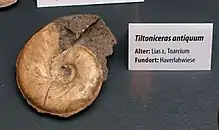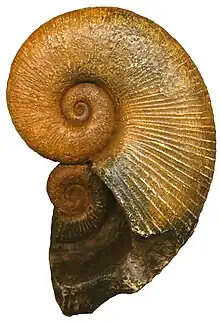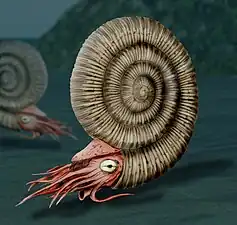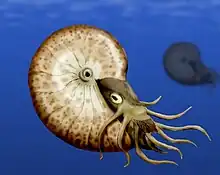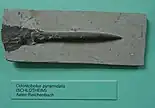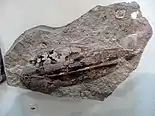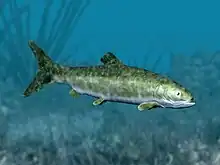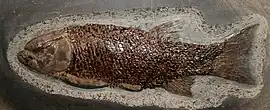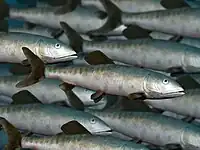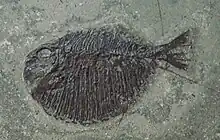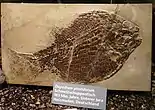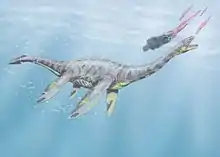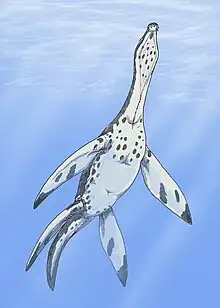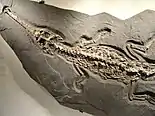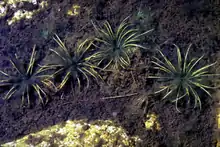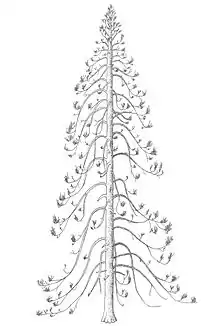Paleobiota of the Ciechocinek Formation
The Ciechocinek Formation is a Jurassic (lower to middle Toarcian) geologic formation which extends across the Baltic coast from Grimmen, Germany, to Nida, Lithuania, with its major sequence in Poland and boreholes in Kaliningrad. Dinosaur species uncovered here, including Emausaurus and other unclassified genus.

| Part of a series on |
| Paleontology |
|---|
 |
|
Paleontology Portal Category |
In Poland, the main basin lacks marine microfauna. The Ciechocinek Formation in the Częstochowa-Zawiercie area reveals the remains of a wide range of prehistoric environments; the Fore-Sudetic Monocline region must have been an extensive bay similar to Lake Maracaibo in Venezuela. The basin's shore zone was a flat, muddy, marshy coastal plain.
The region has the remains of the Wrêczyca River, which was active for most of the Pliensbachian/Toarcian period. At the Brody-Lubienia borehole (Lubienia), which once formed part of the river's east side, an alluvial system ended at a delta and discharged into a shallow marine bay and lagoon. A number of phyllopods and fossilized plant roots have been found here, where they were discharged by the river. Paleosol indicates that the lagoon had a maximum depth of about 6 metres (20 ft).
Foraminifera
Color key
|
Notes Uncertain or tentative taxa are in small text; |
| Genus | Species | Location | Material | Abundance | Notes | Images |
|---|---|---|---|---|---|---|
|
Lingulina[1] |
|
|
Shells |
Abundant |
A marine/brackish Foraminiferan, type member of the family Lingulininae inside Nodosariinae. Reaches percentages of 25% in some samples |
|
|
Nodosaria[1] |
|
|
Shells |
Diverse but Scarce |
A marine/brackish Foraminiferan, type member of the family Nodosariidae inside Nodosariinae. Despite its diversity is very scarce on most samples, with less than 1-2% of presence. |
|
|
Dentalina[1] |
|
|
Shells |
Diverse but Scarce |
A marine/brackish Foraminiferan, member of the family Nodosariidae inside Nodosariinae. |
|
|
Rectoglandulina[1] |
|
|
Shells |
Scarce |
A marine/brackish Foraminiferan, member of the family Nodosariidae inside Nodosariinae. |
|
|
|
Shells |
Scarce |
A marine/brackish Foraminiferan, member of the family Nodosariidae inside Nodosariinae. |
||
|
Frondicularia[1] |
|
|
Shells |
Diverse but Scarce |
A marine/brackish Foraminiferan, member of the family Nodosariidae inside Nodosariinae. |
|
|
Stilostomella[1] |
|
|
Shells |
One specimen |
A marine/brackish Foraminiferan, type member of the family Stilostomellidae inside Nodosariinae. |
|
|
|
Shells |
Diverse but very Scarce |
A marine Foraminiferan, member of the family Vaginulinidae inside Nodosarioidea. |
||
|
Marginulina[1] |
|
|
Shells |
Abundant |
A marine/brackish Foraminiferan, type member of the family Marginulininae inside Vaginulinidae. Marginulina prima reaches a 35% on a few samples |
|
|
Vaginulina[1] |
|
|
Shells |
Scarce |
A marine/brackish Foraminiferan, type member of the family Vaginulininae inside Vaginulinidae. |
|
|
Falsopalmula[1] |
|
|
Shells |
Very Scarce |
A marine/brackish Foraminiferan, member of the family Robuloididae inside Robuloidoidea. |
|
|
Berthelinella[1] |
|
|
Shells |
Very Scarce |
A marine/brackish Foraminiferan, member of the family Plectofrondiculariidae inside Polymorphinina. |
|
|
Eoguttulina[1] |
|
|
Shells |
Scarce |
A marine/brackish Foraminiferan, member of the family Polymorphininae inside Polymorphinina. |
|
|
|
Shells |
Abundant |
A marine/brackish Foraminiferan, type member of the family Bolivinidae inside Bolivinoidea. Reaches 40% of sampled foranimiferans on at least one sample |
||
|
|
Shells |
Moderately present |
A marine/brackish Foraminiferan, member of the family Usbekistaniinae inside Ammodiscidae. Its abundance is lower than other genera, yet reaches peaks of 5-10% in at least one sample. |
||
|
|
Shells |
Present in low numbers |
A marine/brackish Foraminiferan, type member of the family Ophthalmidiidae inside Cornuspiroidea. |
||
|
Cornuspira[1] |
|
|
Shells |
Present in low numbers |
A marine/brackish Foraminiferan, type member of the family Cornuspirinae inside Cornuspiroidea. |
|
|
Turrispirillina[1] |
|
|
Shells |
Very Scarce |
A marine/brackish Foraminiferan, member of the family Spirillinidae inside Spirillinina. |
|
|
Trochamminoides[1] |
|
|
Shells |
Very Scarce |
A marine/brackish Foraminiferan, member of the family Trochamminoidae inside Lituolida. |
|
|
Ammobaculites[2] |
|
|
Shells |
Abundant |
A marine Foraminiferan, member of the family Ammomarginulininae inside Lituolidae. |
|
|
Placopsilina[2] |
|
|
Shells |
Rare |
A marine Foraminiferan, member of the family Lituoloidea inside Lituolida. |
|
|
|
Shells |
Diverse but rare |
A marine Foraminiferan, member of the family Lituoloidea inside Lituolida. |
||
|
Involutina[2] |
|
|
Shells |
Rare |
A marine Foraminiferan, member of the family Ammodiscinae inside Ammodiscina. |
|
|
|
Shells |
Rare |
A marine Foraminiferan, type member of the family Ammodiscinae inside Ammodiscina. Benthic foraminiferal successions heavily dominated by Ammodiscus and Trochammina are known from several Late Triassic to Middle Jurassic sediment packages along the Atlantic margin of northwestern Europe. |
||
|
|
Shells |
Rare |
A marine Foraminiferan, type member of the family Trochammininae inside Trochamminina. Small-sized Ammodiscus–Trochammina assemblages are found associated with delta-influenced shelf environment, where biota would have been stressed by intermittent periods with moderate hypoxia combined with lowered salinity and storm impacts. |
||
|
|
Shells |
Rare |
A marine Foraminiferan, member of the family Saccamminidae inside Astrorhizacea. Sometimes confused with the genus Arlagenammum. |
||
|
|
Shells |
Rare |
A marine Foraminiferan, type member of the family Saccamminidae inside Astrorhizacea. Sometimes confused with the genus Arsaccammum or called Saccamina. The Local specimens are rather rare, incomplete and complicate to identify. |
||
|
Crithionina[2] |
|
|
Shells |
Rare |
A marine Foraminiferan, type member of the family Saccamminidae inside Astrorhizacea. |
|
|
|
Shells |
Rare |
A marine Foraminiferan, type member of the family Vaginulininae inside Nodosarioidea. |
||
Dinoflagellates
| Genus | Species | Location | Material | Abundance | Notes | Images |
|---|---|---|---|---|---|---|
|
Nannoceratopsis[7] |
|
|
Dinocysts |
Dominant |
A marine Dinophyceae Dinoflagellatan, type member of the family Nannoceratopsiaceae inside Nannoceratopsiales. The large amount of Cysts of the genus point to more diversified marine palaeoenvironments. N. senex is the most abundant. Locally Nannoceratopsis recovers series of marine transgressions and regressions, pointing to the presence of interbedding marine and brackish sediments. |
|
|
Luehndea[7] |
|
|
Dinocysts |
Abundant |
A marine Dinophyceae Dinoflagellatan, type member of the family Luehndeoideae inside Mancodiniaceae. Presence of Luehndea spinosa suggests Late Pliensbachian–earliest Toarcian age of studied assemblages. The marine dinoflagellate cyst Luehndea spinosa and foraminiferal linings were found only in the lower half of the Kozłowice succession. |
|
Fungi
| Genus | Species | Location | Material | Notes | Images |
|---|---|---|---|---|---|
|
|
|
Saprophyte fungal Spores from Marine and Deltaic Settings associated with wood and Litter.[8] The frequency of fungal spores on the Polish basin on the Pliensbachian-Toarcian transition is correlated with negative C isotope peaks and enhanced cuticular plant litter accumulation, pointing to the climate-driven enhanced decomposition of wood and rapid destruction of terrestrial carbon, which may have played an important role in the aggravation of the Jurassic Greenhouse disaster.[8] Associated with a high rate of organic burial, the presence of Fungal Matter increased on the Uppermost layers of the Drzewica Formation, with a continued deposition between the T-OAE extinction, and several ups and downs on the Ciechocinek Formation, related with local climate and humidity changes. This is rather a reflection of the efficiency of terrestrial biodegradation.[8] Measured increasing of temperature favored local fungal-mediated decomposition of plant litter, specifically of normally resistant wood.[8] Observed fungal spores represent various morphotypes and resemble superficially other palynogenic detritus, such as spherical Prasinophyceae.[8] In some cases spherical fungal spores show structures related to Hyphae attachments.[8] |
.jpg.webp) Spores found on the Polish are mostly from Saprophyte (wood decomposers) fungi, resembling the extant genera like Scutellinia, which are probably the main origin for the Fungal Spores found on the Ciechocinek Formation | |
|
Amerospores[8] |
|
|
Fungal Spores |
A Saprophyte fungus, member of the family Sordariomycetes inside Ascomycota.[8] Non-filamentous spores with no septations and with no projections longer than the spore body. Related with the extant genus Poronia. Fungal spore peaks linked to a relative and absolute loss of wood suggest a prominent role of fungal wood decomposers.[8] |
_Fr_587104.jpg.webp) Poronia punctata, an extant saprophyte fungus with Amerospores. Similar fungi probably liberated this spores on the Ciechocinek Formation |
|
Phragmospores[8] |
|
|
Fungal Spores |
A Saprophyte fungus, member of the family Dothideomycetes or Sordariomycetes inside Ascomycota.[8] Spores with two or more transverse septa. Related with the extant genus Acanthostigma, facultative pathogen, or beneficial partner of many plant species. Local humidity, though sufficiently high for fungal development throughout the whole T-OAE interval, is therefore thought to have been of a lesser significance for dynamics of fungal decomposition than elevated temperature.[8] |
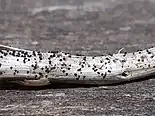 Leptosphaeria acuta, an extant wood fungus with phragmospores |
|
Dictyosporiaceae[8] |
|
|
Fungal Spores |
A freshwater anamorphic fungus, member of the family Pleosporales inside Pleosporomycetidae.[8] Multicellular spore with septations that intersect in more than one plane. Characterized by being mostly aquatic lignicolous species with cheiroid, digitate, palmate, and/or dictyosporous conidia. Related with the extant genus Dictyosporium, recorded worldwide from dead wood, decaying leaves, and palm material. |
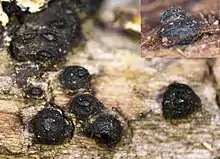 Lophiostoma compressum, an extant wood fungus with dictyospores |
|
Sporonites[9] |
|
|
Fungal Spores |
A True Fungus, member of the family Eumycota inside Eumycetes. It is found associated with Wood Cuticles, Pollen and Spores, interpreted as some sort of parasitism. This genus is found mostly associated with the Blanowice Brown Coals, especially on associated Boreholes. |
.jpg.webp) Sporonites was probably related with a plant parasite fungus or a litter fungus, such as Dicranophora |
Invertebrates
Ichnofossils
| Genus | Species | Type | Location | Material | Origin | Notes | Images |
|---|---|---|---|---|---|---|---|
|
Fodinichnia |
|
Unlined meniscate burrows |
|
Saltwater/Blackish burrow-like ichnofossils. Taenidium is a meniscate backfill structure, usually considered to be produced by an animal progressing axially through the sediment and depositing alternating packets of differently constituted sediment behind it as it moves forward. |
||
|
Fodinichnia |
|
Small branching burrows |
|
Saltwater/Blackish burrow-like ichnofossils. Interpreted as the feeding burrow of a sediment-ingesting animal. A more recent study has found that Scoloplos armiger and Heteromastus filiformis , occurring in the German Wadden Sea in the lower parts of tidal flats, make burrows that are homonymous with numerous trace fossils of the ichnogenus. |
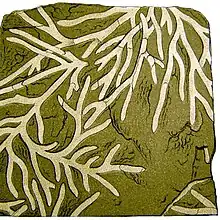 Illustration of Chondrites bollensis | |
|
Domichnia |
|
Cylindrical strands with branches |
|
Blackish trace ichnofossils. Interpreted as dwelling structures of vermiform animals, more concretely the Domichnion of a suspension-feeding Worm or Phoronidan. |
||
|
Megagrapton[11] |
|
Pascichnia |
|
Cylindrical strands with branches |
|
Saltwater/Blackish trace ichnofossils. Probably done by Polychaetes |
|
|
Pascichnia |
|
Cylindrical or elliptical curved/tortuous trace fossils |
|
Saltwater/Blackish burrow-like ichnofossils. Planolites is really common in all types of the Ciechocinek Formation deposits. It is referred to vermiform deposit-feeders, mainly Polychaetes, producing active Fodinichnia. It is controversial, since is considered a strictly a junior synonym of Palaeophycus. |
 Example of Planolites fossil | |
|
Palaeophycus[13] |
|
Domichnia |
|
Straight or gently curved tubular burrows. |
|
Saltwater/Blackish burrow-like ichnofossils. Palaeophycus is less common than Planolites in deposits of the Ciechocinek Formation. On the Kozlowice outcrop however there are numerous specimens occur, interpreted as the result of passive filling of polychaete burrows.[13] |
 Example of Palaeophycus fossil |
|
Fodinichnia |
|
Simple, unbranched, horizontal cylinder traces |
Saltwater/Blackish burrow-like ichnofossils. There are a few specimens in the Kozlowice outcrop. It is interpreted as a grazing trail or Fodinichnia, produced at shallow depth in sediment by Polychaetes and Priapulids.[13] |
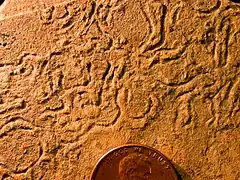 Example of Helminthopsis fossil | ||
|
Gyrochorte[13] |
|
Fodinichnia |
|
Winding, horizontal, double ridge burrows, separated by a median groove. |
|
Saltwater/Blackish burrow-like ichnofossils. On the Kozlowice strata, only a few specimens were observed. Gyrochorte is interpreted as a result of active digging on the sediment by a deposit-feeding worm-like animal, probably Annelid or similar kinds of creatures.[13] |
|
|
Protovirgularia[13] |
|
Pasichnia |
|
Bilobate trace fossil |
|
Saltwater/Blackish and Freshwater bottom Trace Fossils. Protovirgularia is a Repichnia form, ascribed to the activity of Bivalves, leaving a trace due to the rhythmic action of a foot.[13] |
|
|
|
|
Horizontal and subhorizontal, branching tunnels,cylindrical or elliptical in cross-section, displaying elongated striation on exterior of burrow casts |
|
Saltwater/Blackish burrow-like ichnofossils. On the Kozłowice section a series of sand-filled tunnels of Spongeliomorpha are preserved as Endichnia within mudstone, preserved as Tubular Tempestites (Storm-burrow filling), open tubes produced by animals burrowing in a stable, stiff or firm substrate.[14] Here the tubes occur in one horizon with thin sandy laminae and lenses that represent isolated Starved Ripples carried on the muddy sea-floor by storm-generated Traction power network.[14] |
||
|
Fodinichnia |
|
Vertical to oblique, unbranched or branched, elongated to arcuate spreite burrow |
|
Saltwater/Blackish burrow-like ichnofossils. Is common on the Pomerania Region. The overall morphology and details of the burrows, in comparison with modern analogues and neoichnological experiments, suggest Echiurans (spoon worms) or Holothurians (sea cucumbers) with a combined suspension- and deposit-feeding behaviour as potential producers. |
 Teichichnus burrows | |
|
Domichnia |
|
"U"-shaped burrows |
|
Marine-Mangroove Vertical, U-shaped, single-spreite Burrows; unidirectional or bidirectional spreite, generally continuous, rarely discontinuous. Most Diplocraterion show only protrusive spreit, like the local ones, produced under predominantly erosive conditions where the organism was constantly burrowing deeper into the substrate as sediment was eroded from the top. |
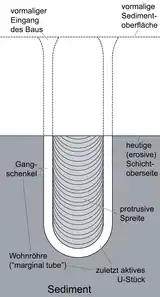 Diplocraterion parallelum diagram | |
Annelida
| Genus | Species | Stratigraphic position | Material | Notes | Images |
|---|---|---|---|---|---|
|
Dictyothylakos[16] |
|
|
Cocoons |
Freshwater Clitellata Cocoons (Oligochaeta and Hirudinea), identified with palynological residues, and through to be tridimensional nets of probable algal origin.[17] Fragmentary mesh-like networks of happiness threads composed of homogenous translucent material. They show the outer wall (hapsine) construction specific to clitellate annelids and lack an alytine (inner) layer. A disorderly meshwork of the hapsine layer and hapsine fibers of unequal thickness, are diagnostic of the type species Dictyothylakos pesslerae. The cocoons Dictyothylakos pesslerae resemble specially those of modern Leechs, and are common on flooded basin sediments, which implies not only the presence of parasitic leeches, but also the presence of large hosts nearby, as has been confirmed on the case of the Ciechocinek Formation, thanks to the presence of not only dinosaurs but also Dipnoi and other freshwater taxa. |
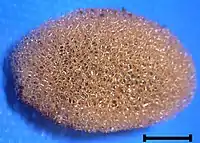 Example of leech cocoon .jpeg.webp) Placobdella, example of leech |
Brachiopoda
| Genus | Species | Stratigraphic position | Material | Notes | Images |
|---|---|---|---|---|---|
|
|
Cunchs |
A Saltwater Brachiopodan, member of Discinidae inside Discinida. The classification of the Discinidae is rather treated with confusion, due to the description and the identification of either extinct and extant genera and species. The shells of this genus are the only identifiable brachiopods of the formation. |
||
Bivalvia
| Genus | Species | Stratigraphic position | Material | Notes | Images |
|---|---|---|---|---|---|
|
|
Shells |
A Saltwater Oyster, member of "Posidoniidae" inside Ostreoida. A genus classified under "Posidonia bronni". Found usually associated with Driftwood. |
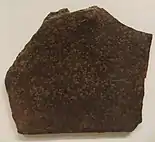 | |
|
|
Shells |
A Saltwater Oyster, member of "Posidoniidae" inside Ostreoida. A genus classified under "Posidonia bronni". |
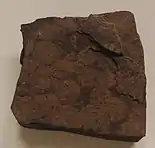 | |
|
Parallelodon[20] |
|
|
Shells |
A Saltwater Ark Clam, member of Parallelodontidae inside Arcida. |
|
|
Tancredia[20] |
|
|
Shells |
||
|
Gresslya[20] |
|
|
Shells |
A Saltwater Clam, member of Ceratomyidae inside Pleuromyoidea. |
|
|
|
Shells |
A Saltwater Clam, member of Inoceramidae inside Myalinida. This genus resemble the Modern Pearl Oysters, although it was more likely a clam. The specimens are rather complete. |
||
|
|
Shells |
A Saltwater/Brackish Clam, member of Inoceramidae inside Myalinida. Pseudomytiloides dubius is a possible junior synonym. This genus resembles the Modern Pearl Oysters, although it was more likely a clam. The specimens are rather complete. It is the most common bivalve found locally. Is also very numerous in young specimens |
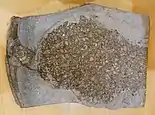 Parainoceramya | |
|
|
Shells |
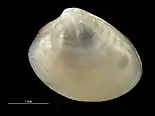 Nucula | ||
|
|
Shells |
A Saltwater Clam, member of Lucinidae inside Lucinida. Very abundant on the layers |
| |
|
|
Shells |
A Saltwater Clam, member of Pholadomyidae inside Pholadomyida. Rather common, but less abundant than other local genera |
||
|
|
Shells |
A Saltwater Scallop, member of Oxytomidae inside Pectinida. Depositional environments in the Polish Basin at this time did not host organisms normally associated with well-oxygenated marine conditions. Meleagrinella substriata is the most common bivalve found on the Toarcian Polish Basin, linked with all the brackish Deposits.[23] |
 Meleagrinella | |
|
|
Shells |
A freshwater mussel, member of the family Unionidae inside Unionida. Associated with plant detritus, likely washed from nearby mainland |
 Lamprotula | |
Gastropoda
| Genus | Species | Stratigraphic position | Material | Notes | Images |
|---|---|---|---|---|---|
|
|
Shells |
Brackish Snails of Uncertain affinity |
||
|
|
Shells |
A holoplanktonic Snail, type member of the family Coelodiscidae inside Prosobranchia. This is the oldest known holoplanktonic gastropod, thanks to bilateral symmetrical shells as an adaption to active swimming. Also the most common of the sea snails on the Clay Pit of Dobbertin, where is one of the most varied in size terms, with some of the biggest specimens of this snail from the Lower Toarcian know. It has been related to large floating driftwood as one of the primary settlers. |
||
|
|
Shells |
A Sea Snail, member of Cerithiinae inside Caenogastropoda. |
| |
|
|
Shells |
A Sea Snail, member of Turritellidae inside Cerithioidea. |
||
|
Lioplacodes[5] |
|
|
Shells |
A Freshwater Snail, member of Viviparidae inside Architaenioglossa. Resembles Lioplacodes veternus |
|
|
|
Shells |
A Freshwater/Terrestrial Snail, member of Planorbidae inside Planorboidea. |
| |
Cephalopoda
| Genus | Species | Stratigraphic position | Material | Notes | Images |
|---|---|---|---|---|---|
|
|
Shells |
An Ammonite, member of the family Hildoceratidae inside Ammonoidea. |
 Eleganticeras | |
|
|
Shells |
An Ammonite, member of the family Hildoceratidae inside Ammonoidea. |
| |
|
|
Shells |
An Ammonite, member of the family Hildoceratidae inside Ammonoidea. |
||
|
Whitbyiceras[20] |
|
|
Shells |
An Ammonite, member of the family Phymatoceratidae inside Ammonoidea. |
|
|
|
Shells |
An Ammonite, member of the family Lytoceratidae inside Ammonoidea. |
| |
|
|
Shells |
An Ammonite, member of the family Harpoceratinae inside Ammonoidea. |
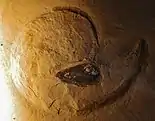 Pseudolioceras | |
|
|
Shells |
An Ammonite, type member of the family Dactylioceratinae inside Ammonoidea. Most common ammonite found on the Green Series and the different erratic boulders, as is the most common on the German realm, on the north and the south, with several specimens of different sizes. |
| |
|
|
Shells |
An Ammonite, type member of the family Dactylioceratinae inside Ammonoidea. |
||
|
|
Shells |
An Ammonite, member of the family Dactylioceratinae inside Ammonoidea. |
||
|
|
Shells |
An Ammonite, type member of the family Phylloceratinae inside Ammonoidea. |
| |
|
|
Multiple Specimens. |
A Belemnoidean. member of the family Megateuthididae inside Belemnitida. |
| |
|
Beloteuthis[19] |
|
|
Multiple Specimens |
A Mesoteuthoidean, member of the family Beloteuthidae. Is a relatively small genus. |
.jpg.webp) Beloteuthis |
|
|
Few specimens |
A Vampire Squid, member of Teudopsidae inside Vampyropodan. Related to the modern Vampyroteuthis infernalis. |
| |
|
Jeletzkyteuthis[19] |
|
|
Two Specimens |
A Loligosepiidae Loligosepiidan (Vampyromorpha). Related to the modern Vampyroteuthis infernalis. Gladii of Loligosepia can be distinguished from Jeletzkyteuthis by the transition lateral field/hyperbolar zone. Described originally as Belopeltis bollensis. |
|
Crustacea
Small indeterminate shrimps, sometimes found associated in great numbers, are recovered on several layers at Grimmen.[28]
| Genus | Species | Stratigraphic position | Material | Notes | Images |
|---|---|---|---|---|---|
|
|
Valves |
A Freshwater Clam shrimp (Phyllopodan) of the family Lioestheriidae. Originally identified as a bivalve of the genus "Posidonia" and latter a member of the genus Lioestheria. They fed on detritus, being very small slow moving, nektonic organisms that filter fed as they floated. Euestheria opalina dominates the invertebrate assamblages. The specimens are numerous here and form thin layers, being the most abundant invertebrate recovered on all the formation. The presence of Euestheria marks the appearance of less saline conditions, as this is a mostly freshwater genus. Is linked with beds where abundant freshwater algae covers the layers, being both probably washed from the nearby mainland trought streams. The local Phyllopods are related with a great amount of freshwater debris (especially plants), and suggest seasonal changes on the rivers on the Toarcian Polish Basin. On Kozłowice, there is an association of the ichnogenus Planolites and phyllopods of this genus, which reflects a gradual decline in water salinity during a sea level high standard regression. |
||
|
|
Valves |
A Freshwater Clam shrimp (Phyllopodan) of the family Eosestheriidae. |
||
|
|
|
A Marine Decapodan, type member of the family Glypheidae inside Decapoda. |
| |
|
|
|
A Marine Decapodan, member of the family Proeryoninae inside Polychelida. Resemble Proeryon hartmani show less adaptations to hunt for small nectobenthic preys than other relatives, being abundant on Oyster-filled waters. There is a relative abundance of the genus in deep-water settings from the Toarcian onward. |
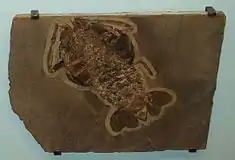 Proeryon | |
|
|
Valves |
A Marine Ostracodan of the family Pontocyprididae. Small marine ostracods related with abundant Green Algae environments |
||
|
Trachycythere[1] |
|
|
Valves |
A marine/brackish Ostracodan of incertae sedis affinity |
|
|
Paracypris[1] |
|
|
Valves |
A marine/brackish Ostracodan of the family Paracypridinae inside Candonidae. |
|
|
Bythocypris[1] |
|
|
Valves |
A marine/brackish Ostracodan of the family Bythocyprididae inside Bairdioidea. |
|
|
Bairdia[1] |
|
|
Valves |
A marine/brackish Ostracodan of the family Bairdiidae inside Bairdioidea. |
|
|
Polycope[1] |
|
|
Valves |
A marine/brackish Ostracodan of the family Polycopidae inside Cladocopina. |
|
|
Procytheridea[1] |
|
|
Valves |
A marine/brackish Ostracodan of the family Protocytheridae inside Cytheroidea. |
|
|
Cytherelloidea[1] |
|
|
Valves |
A marine/brackish Ostracodan of the family Cytherelloidea inside Platycopina. |
|
|
Hungarella[1] |
|
|
Valves |
A marine/brackish Ostracodan of the family Healdiidae inside Metacopa. Hungarella adenticulata was first identified in Dobbertin |
|
Arachnida
| Genus | Species | Stratigraphic position | Material | Notes | Images |
|---|---|---|---|---|---|
|
|
Single Incomplete Specimen |
A spider, possible member of the superfamily Palpimanoidea.[33] It is the first confirmed spider from the lower Jurassic, and a rare find, probably washed to the sea due to a hard wind related to hurricane action. Probably a ground-dwelling predator that hunted the abundant insect fauna present on the layers.[33] With a robust and well-armed legs I, directed forwards give the suggestion that they were preycapture appendages, a morphology typical of a sit-and-wait predator, while the short legs III are more typical on web spiders, especially Orbweavers, but also found on Palpimanoids, but not on that that are common substrate dwellers, that had legs more equal.[33] Seppo was probably not a habitual ground dweller, with armoured front legs related to capturing dangerous prey, such as many palpimanoids today are Araneophagous, for example.[33] |
||
Insecta
Insects are common terrestrial animals that were probably drifted to the sea due to Moonsonal conditions present on the Ciechocinek Formation.[34] In Klein Lehmhagen insects are found as part of calcareous nodules in the exaratum-elegantulum subzones, with specimens also found in living chambers of Eleganticeras elegantulum macrochonchs and in fish coprolites which are the most frequent fossils at all.[34] In the elegantulum the insect fauna is dominated by beetle elytra, indicating strong fluvial input and a nearshore deltaic complex.[34] On Dobbertin, insects are present in the exaratum nodules, where fluvial input is seen thanks to the phyllopod abundance and whole bedding planes covered by algae substituted by Ca-phosphat, being the layers where insects are most abundant.[34]
| Genus | Species | Stratigraphic position | Material | Notes | Images |
|---|---|---|---|---|---|
|
|
Specimens |
A Paraneopteran, member of the family Archipsyllidae inside Permopsocida. |
||
|
Liassopsocus[36] |
|
|
Specimens |
A Paraneopteran, member of the family Psocidiidae inside Permopsocida. |
|
|
|
|
Primitive Pterygotans, member of the family Protomyrmeleontidae inside Dicondylia. |
||
|
| ||||
|
|
Specimens |
Reculidans, member of Gryllones (Extinct clade of Basal Insects) of the family Geinitziidae. |
||
|
| ||||
|
Nele[36] |
|
|
Partial Specimens |
An Ice crawler, member of the family Bajanzhargalanidae inside Grylloblattodea. One of the main Floor insects found. |
.jpg.webp) Grylloblatta, extant ice crawler, Nele was probably similar |
|
|
Specimens |
An Eoblattidan, member of the family Blattogryllidae inside Eoblattida. |
||
|
Undacypha[36] |
|
|
Specimens |
Thysanopterans, members of the family Lophioneurida inside Thripida. Aeroplankton is extraordinarily well preserved in Grimmen, with the most abundant representatives of the aeroplankton (around 3 mm) being Lophioneurids, specially Undacypha europaea. |
 Extant Thysanopteran, extinct genera were probably similar |
|
Liadoptilia[40] |
|
| |||
|
Trichorthophlebia[40] |
|
| |||
|
|
|
A dragonfly, incertae sedis inside Odonata. Magnasupplephlebia represents a very large dragonfly, with a wingspan of 13 cm. Other odonatan remains are unable to being referred to a concrete group due to their incomplete status. |
||
|
| ||||
|
Petrothemis[35] |
|
| |||
|
Parelthothemis[35] |
|
| |||
|
Anomothemis[35] |
|
| |||
|
Rhabdothemis[40] |
|
| |||
|
Temnostigma[40] |
|
| |||
|
Pycnothemis[40] |
|
| |||
|
| ||||
|
|
Specimens |
A Dragonfly, member of the family Liassogomphidae inside Odonata. |
||
|
Anisozygopteron[35] |
|
|
Specimens |
A Dragonfly, member of the family Myopophlebiidae inside Odonata. |
|
|
Selenothemis[38] |
|
|
Specimens |
A Dragonfly, type member of the family Selenothemistidae inside Odonata. |
|
|
Dialothemis[40] |
|
| |||
|
Eosagrion[38] |
|
|
Specimens |
A Dragonfly, member of the family Eosagrionidae inside Odonata. |
|
|
Turanopteron[36] |
|
|
Specimens |
A Dragonfly, member of the family Asiopteridae inside Odonata. "Sphenophlebia pommerana" is a junior synonym. |
|
|
Grimmenopteron[36] |
|
|
Specimens |
A Dragonfly, member of the family Liassophlebiidae inside Odonata. |
|
|
Trigonophlebia[36] |
|
|
Specimens |
A Dragonfly, member of the family Heterophlebiidae inside Odonata. |
|
|
|
Specimens |
A Dragonfly, member of the family Heterophlebiidae inside Odonata. |
||
|
Dobbertiniopteryx[45] |
|
|
Specimens |
A small winter Stonefly, member of the family Capniidae inside Plecoptera. |
_(16475370865).jpg.webp) extant Capniidae, Dobbertiniopteryx was probably similar |
|
Dicronemoura[36] |
|
|
Specimens |
A stonefly, member of the family Perlariopseidae inside Plecoptera. |
|
|
Zalmonites[35] |
|
|
Specimens |
A grasshopper, incertae Sedis inside Orthoptera. |
|
|
|
|
A Grasshopper, member of the family Elcanidae inside Orthoptera. The species Panorpidium magna is among the largest Orthopterans of the Jurassic, while Panorpidium minima is among the smallest. |
||
|
| ||||
|
| ||||
|
|
|
Grasshoppers of the family Locustopsidae inside Orthoptera. |
||
|
Plesioschwinzia[47] |
|
| |||
|
Schwinzia[48] |
|
| |||
|
Locustophanes[40] |
|
|
Specimens |
A Locust, type member of the family Locustidae inside Orthoptera. |
.jpg.webp) Acanthacris, extant Locust, Locustophanes was probably similar |
|
|
Specimens |
A Grasshopper, member of the family Regiatidae inside Orthoptera. |
||
|
|
Specimens |
A Cricket-like Grasshopper, type member of the family Protogryllidae inside Orthoptera. |
||
|
|
Specimens |
A Stick Insect, member of the family Aerophasmidae inside Phasmatodea. |
.jpg.webp) Example of extant Phasmatodean, Durnovaria was probably similar | |
|
|
Specimens |
A Cockroach, type member of the family Mesoblattinidae inside Blattodea. |
||
|
|
Specimens |
A Cockroach, type member of the family Caloblattinidae inside Blattodea. |
||
|
|
Specimens |
A Carnivorous Cockroach, type member of the family Raphidiomimidae inside Blattodea. |
||
|
Eublattula[40] |
|
|
Specimens |
A Cockroach, member of the family Blattulidae inside Dicondylia. Member of an extinct cockroach-like family which was widely distributed around the world and lasted from Late Triassic to Cretaceous. |
|
|
| ||||
|
| ||||
|
Liasocoris[52] |
|
|
Specimens |
A true bug, incertae sedis inside Hemiptera. |
|
|
|
|
Planthoppers of the family Fulgoridiidae inside Hemiptera. The colossal abundance of the genus Fulgoridium maybe it is related to a preference for seashore habitats. Some specimens are indistinguishable, making possible some species synonymous. |
 Example of extant Fulgoridae, Fulgoridiidae genera where probably similar | |
|
Metafulgoridium[40] |
|
| |||
|
Margaroptilon[40] |
|
| |||
|
Cixiites[35] |
|
| |||
|
|
Specimens |
Froghoppers of the family Procercopidae inside Hemiptera. |
||
|
Procercopina[36] |
|
| |||
|
|
Specimens |
A jumping plant louse, member of the family Liadopsyllidae inside Hemiptera. |
||
|
Hadrocoris[40] |
|
|
Specimens |
A true Bug, member of the family Hadrocoridae inside Hemiptera. |
|
|
Acromocoris[53] |
|
|
Specimens |
A water boatman, member of the family Corixidae inside Hemiptera. |
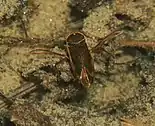 Example of extant Corixidae, Acromocoris was probably similar |
|
|
Specimens |
Moss bugs of the family Progonocimicidae inside Hemiptera. |
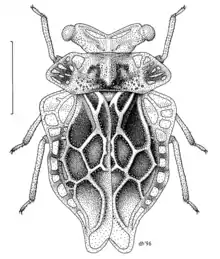 Example of extant Peloridiidae, Progonocimicidae genera where probably similar | |
|
Eocercopis[40] |
|
| |||
|
Archicercopis[40] |
|
| |||
|
|
Specimens |
A Coleorrhynchan, member of the family Probascanionidae inside Hemiptera. |
||
|
|
Specimens |
Shore bugs, member of the family Archegocimicidae inside Hemiptera. |
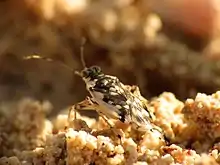 Example of extant Pentacora, Archegocimicidae genera where probably similar | |
|
Progonocoris[38] |
|
| |||
|
Anosmus[40] |
|
| |||
|
Diatillus[43] |
|
| |||
|
Pachymeridium[10] |
|
|
Specimens |
True Bugs, member of the family Pachymeridiidae inside Hemiptera. |
|
|
Sisyrocoris[43] |
|
| |||
|
Hypocimex[40] |
|
| |||
|
Apsicoria[40] |
|
| |||
|
Cathalus[40] |
|
| |||
|
Psychrocoris[43] |
|
| |||
|
Cuneocoris[38] |
|
|
Specimens |
A true Bug, member of the family Cuneocoridae inside Hemiptera. |
|
|
Apopnus[43] |
|
|
Specimens |
A creeping water bug, member of the family Naucoridae inside Hemiptera. |
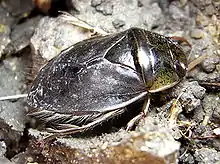 Example of extant Naucoridae, extinct genera where probably similar |
|
| ||||
|
|
Specimens |
Leafhoppers of the family Archijassidae inside Hemiptera. |
.jpg.webp) Example of extant Membracidae, Archijassidae genera where probably similar | |
|
| ||||
|
Ardela[36] |
|
| |||
|
Liassocercopis[36] |
|
|
Specimens |
A cicadomorphan, member of the family Hylicellidae inside Hemiptera. |
|
|
Toarcopsyllidium[36] |
|
|
Specimens |
A Sternorrhynchan, member of the family Protopsyllidiidae inside Hemiptera. |
|
|
Aphidulum[36] |
|
| |||
|
|
Specimens |
A Stemorrhynchan, type member of the family Archiconiopterygidae inside Hemiptera. |
||
|
Grimmenaphis[36] |
|
|
Specimens |
An aphid, member of the family Oviparosiphidae inside Hemiptera. Among the oldest Aphids |
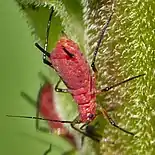 Example of extant Aphidoidea, Oviparosiphidae genera where probably similar |
|
Grimmaratavites[55] |
|
|
Specimens |
A Wood Wasp, member of the family Karatavitidae inside Hymenoptera. |
|
|
Liadobracona[56] |
|
|
Isolated Wings |
Wasps, member of the family Ephialtitidae inside Hymenoptera |
|
|
Brigittepterus[56] |
|
| |||
|
Xyelula[56] |
|
|
Specimens |
A pseudo-Wasp, member of the family Sepulcidae inside Hymenoptera. |
|
|
Dobbertinia[38] |
|
|
Specimens |
An alderfly, member of the family Sialidae inside Megaloptera. |
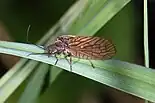 Example of extant Sialidae, Dobbertinia was probably similar |
|
|
Specimens |
A Neuropteran of the family Mantispidae. It is the earliest know Chrysopid |
.jpg.webp) Example of extant Mantispidae, Liassochrysa was probably similar | |
|
Mesoleon[35] |
|
|
Isolated Wings |
A lacewing, incertae sedis inside Neuroptera. The wings if this neauropterans are rather fagmentary and its inclusion on any extant or extinct family is complex |
|
|
Loxophleps[40] |
|
| |||
|
Melaneimon[40] |
|
| |||
|
Melamnous[40] |
|
| |||
|
|
Isolated Wings |
Lacewings of the family Prohemerobiidae inside Neuroptera. |
||
|
| ||||
|
Mesosmylina[36] |
|
|
Specimens |
A lance lacewing, member of the family Osmylidae inside Neuroptera. |
|
|
Solenoptilon[59] |
|
|
Specimens |
A lacewing, type member of the Family Solenoptilidae inside Neuroptera. |
|
|
|
Specimens |
A lacewing, member of the Family Epigambriidae inside Neuroptera. Members of the macrofamily Ithonidae |
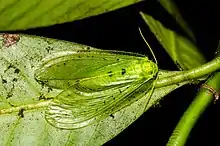 Example of extant Ithonidae, Epigambriidae members where probably similar | |
|
| ||||
|
Apeirophlebia[35] |
|
|
Specimens |
A silky lacewing, member of the Family Psychopsidae inside Neuroptera. An unexpected giant Silky lacewing, with a size up to 7 cm. |
.jpg.webp) Example of extant Psychopsidae, Apeirophlebia was probably similar |
|
Toarciconiopteryx[61] |
|
|
Isolated hind wing |
A dustywing, member of the Family Toarciconiopteryginae inside Neuroptera. The oldest representative of the family |
 Example of extant Coniopterygidae, Toarciconiopteryx was probably similar |
|
Parnidium[35] |
|
|
Isolated Elytrons |
Beetles, incertae sedis inside Coleoptera. Great amount of Beetle elytrons on both Dobbertin and Grimmen corroborates the presence of suitable environments nearby. |
|
|
Polypamon[62] |
|
| |||
|
Bathygerus[62] |
|
| |||
|
Plastonebria[62] |
|
| |||
|
Plastobuprestites[62] |
|
| |||
|
Nannoodes[35] |
|
| |||
|
Pseudocyphon[35] |
|
| |||
|
Keleusticus[62] |
|
| |||
|
Allognosis[62] |
|
| |||
|
Enamma[35] |
|
| |||
|
Pseudoprionites[62] |
|
| |||
|
Nebrioides[62] |
|
| |||
|
Paracurculium[62] |
|
| |||
|
Apioderes[40] |
|
| |||
|
Bareus[40] |
|
| |||
|
Anypostatus[40] |
|
| |||
|
Periboloptera[40] |
|
| |||
|
Clinomerus[40] |
|
| |||
|
Anomerus[40] |
|
| |||
|
Masselytron[40] |
|
| |||
|
Oxytoroptera[40] |
|
| |||
|
Ecthlimma[40] |
|
| |||
|
Onkedodimus[40] |
|
| |||
|
Apsychus[40] |
|
| |||
|
| ||||
|
Anancaeon[40] |
|
| |||
|
Hydrobiites[40] |
|
|
Elytrons |
A beetle, member of the family Permosynidae inside Coleoptera. |
|
|
Thoracotes[35] |
|
|
|
A bark gnawing beetle, member of the family Trogossitidae inside Coleoptera. |
.jpg.webp) Example of extant Trogossitidae, Thoracotes was probably similar |
|
Eurynucha[35] |
|
|
Isolated Elytrons |
A jewel beetle, member of the family Buprestidae inside Coleoptera. |
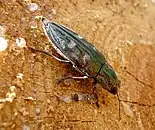 Example of extant Buprestidae, Eurynucha was probably similar |
|
Coptogyrinus[35] |
|
|
Specimens |
A whirligig beetle, member of the family Gyrinidae inside Coleoptera. |
_(14805555906).jpg.webp) Example of extant Gyrinidae, Coptogyrinus was probably similar |
|
|
Specimens |
A ground beetle, member of the family Carabidae inside Coleoptera. |
.jpg.webp) Example of extant Carabidae, Carabites was probably similar | |
|
Liassodites[63] |
|
|
|
A False Ground Beetle of the family Trachypachidae. |
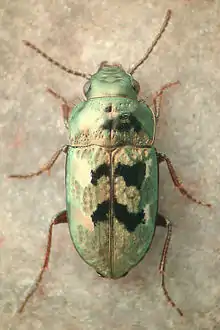 Extant member of Trachypachidae, Liassodites was probably similar |
|
|
Isolated Wings |
Caddisflies, member of the family Necrotauliidae inside Trichoptera. |
||
|
Metarchitaulius[40] |
|
| |||
|
Parataulius[40] |
|
| |||
|
Nannotrichopteron[35] |
|
| |||
|
| ||||
|
Epididontus[40] |
|
| |||
|
Archiptilia[40] |
|
| |||
|
Paratrichopteridium[40] |
|
| |||
|
Pararchitaulius[40] |
|
| |||
|
Palaeotaulius[40] |
|
| |||
|
Pseudorthophlebia[35] |
|
| |||
|
|
Specimens |
A finger-net caddisfly, member of the family Philopotamidae inside Trichoptera. |
 Example of extant Philopotamidae, Liadotaulius was probably similar | |
|
|
|
A Moth, member of the family Eolepidopterigidae inside Lepidoptera. They are essential fossils for the Development of the color on Lepidopterans. |
||
|
|
|
Hangingflies, member of the family Orthophlebiidae inside Mecoptera. |
||
|
Mesopanorpa[40] |
|
| |||
|
|
|
Hangingflies, member of the family Bittacidae inside Mecoptera. |
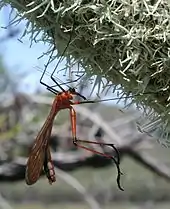 Example of extant Bittacidae, extinct members where probably similar | |
|
Parabittacus[66] |
|
| |||
|
Mesobittacus[36] |
|
| |||
|
|
Specimens |
A scorpionfly, type member of the family Pseudopolycentropodidae inside Mecoptera. |
||
|
Mesochorista[40] |
|
|
Specimens |
A Scorpionfly, member of the family Permochoristidae inside Mecoptera. |
|
|
|
Isolated Wings |
|||
|
Aenne[68] |
|
|
|
The oldest known non biting Midges, members of the Chironomidae inside Diptera |
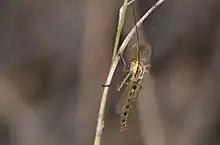 Example of extant Chironomidae, extinct members where probably similar |
|
| ||||
|
| ||||
|
|
|
A Crane Fly of the family Limoniidae inside Diptera. |
.jpg.webp) Example of extant Limoniidae, extinct members where probably similar | |
|
| ||||
|
Eotipula[35] |
|
| |||
|
| ||||
|
Grimmenia[69] |
|
| |||
|
Rhaetomyia[36] |
|
|
Specimens |
A Phantom midge of the family Chaoboridae inside Diptera. |
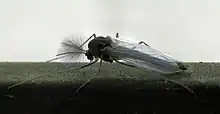 Example of extant Chaoboridae, extinct members where probably similar |
|
Grimmyia[36] |
|
|
Isolated Wings |
A Snipe Fly, member of the family Rhagionidae inside Diptera. |
 Example of extant Rhagionidae, extinct members where probably similar |
|
| ||||
|
Palaeobrachyceron[36] |
|
| |||
|
Antefungivora[36] |
|
|
Isolated Wings |
Flies, member of the family Antefungivoridae inside Diptera. |
|
|
Archibio[40] |
|
| |||
|
Pleciofungivora[36] |
|
|
Isolated Wings |
A Fly, member of the family Pleciofungivoridae inside Diptera. |
|
|
Archirhyphus[40] |
|
|
Isolated Wings |
||
|
| ||||
|
Protobrachyceron[38] |
|
|
Specimens |
A Fly, member of the family Protobrachyceridae inside Diptera |
|
|
|
Specimens |
A Fly, type member of the family Heterorhyphidae inside Diptera |
||
|
Eoditomyia[36] |
|
|
Specimens |
A Fly, type member of the family Eoditomyidae inside Diptera |
|
|
|
Isolated wings |
A Fly, type member of the family Protopleciidae inside Diptera. |
||
|
Mailotrichocera[72] |
|
|
Isolated wings |
A Winter Crane Fly, member of the family Trichoceridae inside Diptera. |
_-_(imago)%252C_Elst_(Gld)%252C_the_Netherlands_-_3.jpg.webp) Example of extant Trichoceridae, extinct members where probably similar |
|
|
Isolated Wings |
A primitive Crane Fly, member of the family Tanyderidae inside Diptera. |
||
|
Praemacrochile[74] |
|
| |||
|
|
Isolated Wings |
A Phantom crane fly, member of the family Ptychopteridae inside Diptera. |
_-_(male_imago)%252C_Arnhem%252C_the_Netherlands.jpg.webp) Example of extant Ptychopteridae, extinct members where probably similar | |
|
Eolimnobia[35] |
|
| |||
|
Crenoptychoptera[75] |
|
| |||
|
Tanypsycha[73] |
|
|
Isolated Wings |
A Moth fly, member of the family Psychodidae inside Diptera. |
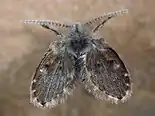 Example of extant Psychodidae, extinct members where probably similar |
|
Liassopsychodina[73] |
|
| |||
|
|
Isolated Wings |
A Wood Gnat, member of the family Anisopodidae inside Diptera. |
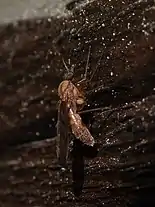 Example of extant Anisopodidae, extinct members where probably similar | |
|
Metatrichopteridium[76] |
|
|
Isolated Wings |
||
Echinodermata
In Dobbertin, the echinoderm remains are rare in contrast to foraminifera, phyllopods and ostracods, yet in some places they attain a percentage of the total fauna between 0.7-26.5%.[1] In the upper layers they're totally absent, as well on the erractics and in the whole Grimmen sequence.[77]
| Genus | Species | Stratigraphic position | Material | Notes | Images |
|---|---|---|---|---|---|
|
Sinosura[1] |
|
|
|
A Brittle Star, member of Ophioleucidae inside Ophioleucida. Identified as Ophiura longivertebralis. The majority of the Echinoderm material found belong to this genus and overall to Ophiuroids. This can be related to the fact some Ophiuroids are more tolerant with Brackish waters. |
|
|
|
|
Indeterminate Crinoid remains. This group has very limited/scarce record on the facies |
||
|
|
|
A sea Cucumbers of uncertain placement. Remains of this group are very rare on the layers. |
||
Vertebrates
Actinopteri
| Genus | Species | Stratigraphic position | Material | Notes | Images |
|---|---|---|---|---|---|
|
|
|
Freshwater/Brackish/Marine Osteichthyes, incertae sedis inside Teleostei. Inconclusive remains of fish (mostly teeth) are found mostly on Częstochowa-Wieluń region. The Remains of fish are rather rare on the Polish Realm of the Formation, and found related with the Silesian coast, where embayments and lagoons were formed. The remains were not compared. The lack of typical marine fauna indicates that the Toarcian sea transgression did not cause the development of normal-marine conditions in the Polish Basin. "Type A" and "Type B" includes fragmentary remains that resemble the genera Dapedium and andya, with rounded teeth. "Type C" is more similar to the genus Ptycholepis. Finally, "Type D" & "Type E" resemble the Amiiformes and Osteoglossiformes. |
||
|
|
|
A marine/brackish Osteichthyes, member of Palaeonisciformes inside Chondrostei. Fish tooth remains of this genus are found mostly in Kujawy (Aleksandrów I), along with marine foraminifers of the genus Haplophragmoides sp., which indicates a marine deposition. It represents a relict genus and resembles the Late Jurassic Pteroniscus turkestanensis |
||
|
|
|
A Freshwater/brackish/marine Osteichthyes, type member of the family Saurichthyidae inside Chondrostei. This genus is known mostly from the late Triassic deposits on Europe, making its appearance on Toarcian strata superficially dubious. It can be a member of the genus Saurorhynchus, although this last one has never been found on Brackish-Prodeltaic Strata. |
| |
|
|
|
A marine/brackish Osteichthyes, the youngest representative of the family Saurichthyidae inside Chondrostei. Distinctive for its large jaws, similar to modern Belonidae, it is a genus known from several locations across Europe on the Lower-Middle Jurassic. |
| |
|
|
GPIH 4864, Hyomandibula |
A marine Osteichthyes, member of the Chondrosteidae inside Acipenseriformes. |
| |
|
Grimmenichthys[80] |
|
|
Articulated, but incompletely preserved specimen |
A marine Osteichthyes, member of the family Pholidophoriformes inside Teleostei. Found Exclusively on the Green Series, this genus was a small 'pholidophoriform' teleost. The total length remains unknown due to poor preservation, but probably does not exceed 100 mm. |
|
|
|
|
A marine Osteichthyes, member of the family Pholidophoriformes inside Teleostei. |
| |
|
Pholidophoriformes[80] |
|
|
|
A marine Osteichthyes, member of the family Pholidophoriformes inside Teleostei. Resmble Pholidophoroides crenulata and P. limbata. |
|
|
|
Various specimens |
A marine Osteichthyes, member of the family Lepidotidae inside Lepisosteiformes. Various species of the genus probably lived in the zone, yet the relationships of the fossils weren't studied. Stomach content is also preserved on a specimen from Dobbertin, and is composed by arthropod cuticles.[84] |
| |
|
|
GG 439/4-7 scales |
The oldest confirmed true Gar, member of the Lepisosteidae inside Lepisosteiformes. The oldest reliable lepisosteiform remains. |
 Lepisosteus extant example of Gar | |
|
|
Unknown, only cited. |
A marine Osteichthyes, member of the family Pachycormiformes inside Teleostei. The first find of the group in the region. |
||
|
Lycopteroidarum[81] |
|
|
|
Brackish/Freshwater Osteichthyes otoliths of the family Lycopteroidea inside Lycopteriformes. |
|
|
|
|
A marine Osteichthyes, type member of the family Leptolepidae inside Teleostei. The most abundant vertebrate recovered on the formation, including 3D preserved specimens, as well, is the main component of the Fishbone sandstones from the upper layers. |
| |
|
Indeterminate |
|
|
A marine Osteichthyes, member of the family Leptolepidae inside Teleostei. |
||
|
Proleptolepis sp. |
|
|
A marine Osteichthyes, member of the family Leptolepidae inside Teleostei. Proleptolepis in the lower Toarcian of Grimmen suggests that this genus might have had a much wider palaeobiogeographical and temporal distribution, since specimens attributed to Proleptolepis have previously been reported only from the Sinemurian of western Europe. |
||
|
|
|
A marine Osteichthyes, member of the family Semionotidae inside Semionotiformes. Dapedium and Tetragonolepis may have used alternative strategies in order to partition food resources efficiently and avoid direct competition. |
| |
|
|
Almost complete left prearticular with dentition |
A marine Osteichthyes, Member of the family Pycnodontiformes inside Neopterygii. Is of comparatively small size, suggesting a hypothetical small standard length of the fish of about 7–10 cm at the time of death.[88] It is a taxon that shows clear adaptations to durophagy, inferring a predominant diet of especially hard food items.[88] |
||
|
|
Incomplete skull |
A marine Osteichthyes, type member of the Dapediidae inside Neopterygii. |
| |
Chondrichthyes
| Genus | Species | Stratigraphic position | Material | Notes | Images |
|---|---|---|---|---|---|
|
|
|
Marine/Brackish/Freshwater sharks, incertae sedis inside Selachimorpha. Related with the local marine Transgression, the fossils are recovered mostly from an embayment-derived environment. Together with the rather poor fauna recovered on the main part of the region, the transgression spread out over Mudflats and alluvial Floodplains, to which small amounts of sand were still sporadically supplied during stronger floods. |
||
|
|
|
A marine Shark, member of the Hybodontiformes. Related to Hybodus hauffianus and other genera from the south of Germany. A Pliensbachian-aged deposit from Grimmen outcrop has revelated a pretty diverse Chondrichthyan fauna, including two species of the genus: Hybodus reticulatus & Hybodus hauffianus.[90] |
| |
Sarcopterygii
| Genus | Species | Location | Material | Notes | Images |
|---|---|---|---|---|---|
|
Ceratodus sp. |
|
|
A freshwater lungfish, type member of the Ceratodontidae inside Ceratodontiformes. Can be related to the Polish Triassic genus Ceratodus silesiacus (Roemer, 1870), known from several isolated tooth plates found in the lacustrine Triassic horizon of Krasiejów. Several impressions of scales found in other boreholes can also belong to lungfish. The tooth plates were found at +819 m depth on Pomerania, on a layer with gray-green mudstone, lenticular lamination and siderite concretions. The abundance of megaspores indicate a deltaic or brackish environment. |
 Ceratodus reconstruction | |
Ichthyosaurs
| Genus | Species | Stratigraphic position | Material | Notes | Images |
|---|---|---|---|---|---|
|
|
Posterior left half of the cranium. |
An Icthyosaur of the family Stenopterygiidae inside Thunnosauria. A common Toarcian Ichthyosaur, present on multiple layers. The rather exquisite level of preservation has led to know even the coloration. |
||
|
|
Four articulated tail vertebrae. |
An indeterminate ichthyosaur, has been assigned to the species Stenopterygius longifrons. |
||
|
|
Partial skull and associated postcranial elements preserved in a concretion |
An indeterminate ichthyosaur. It has an expanded basipterygoid process on the basisphenoid, only currently known in members of the Ophthalmosauridae |
||
|
|
|
An indeterminate ichthyosaur. |
||
|
|
|
An Icthyosaur, type member of Temnodontosauridae inside Neoichthyosauria. Assigned to Ichthyosaurus sp., but also suggested affinities to "Leptopterygius" (= Temnodontosaurus) platyodon. |
 Restoration | |
Sauropterygia
| Genus | Species | Stratigraphic position | Material | Notes | Images |
|---|---|---|---|---|---|
|
|
|
A marine plesiosaur, member of the family Plesiosauria inside Sauropterygia. Non assigned to a concrete genus, probably are related to the Plesiosaurian genera from the Posidonia Shale |
||
|
|
|
A marine plesiosaur, member of the family Plesiosauria inside Sauropterygia. Non assigned to a concrete genus, probably are related to the Plesiosaurian genera from the Posidonia Shale |
||
|
|
|
A plesiosaur, member of the family Plesiosauridae inside Plesiosauroidea. Related with the German Realm Fauna |
| |
|
|
|
A pliosauroid, member of the family Rhomaleosauridae inside Pliosauroidea. |
| |
Crocodyliformes
| Genus | Species | Stratigraphic position | Material | Notes | Images |
|---|---|---|---|---|---|
|
|
Cervical vertebra |
A Crocodrilian, member of Mesoeucrocodylia. This cervical vertebra has resemblances with terrestrial suchians, such as Dianchungosaurus, but also cervicals of Sichuanosuchus. Is considered to come from an osteologically immature individual. |
| |
|
|
|
A Crocodrylomorph, member of the family Thalattosuchia inside Neosuchia. Distinctive of the marine teleosaurid genus Macrospondylus. |
||
|
|
Partial rostrum with teeth |
A marine Crocodrylomorph, member of the family Teleosauridae inside Teleosauroidea. The tooth morphology and the internal rostral anatomy indicate that it can be positively referred to a longistrine thalattosuchian crocodyliform. The size of PLM uncatalogued, as compared to the corresponding portions of the rostra of other Toarcian thalattosuchians, is indicative of a juvenile individual, with expected around 200–250 mm long skull and the entire animal about 1.50 m.[98] |
||
|
|
Incomplete skull and associated osteoderm |
A marine Crocodrylomorph, member of the family Machimosauridae inside Teleosauroidea. A marine crocodylomorph with a diet probably based on fish. It was identified as Steneosaurus. Although highly incomplete, the preserved maximum antorbital width of about 50 mm demonstrates that GG 422/6 can be clearly referred to an immature individual. |
| |
Dinosauria
| Genus | Species | Stratigraphic position | Material | Notes | Images |
|---|---|---|---|---|---|
|
Megalosauridae Indeterminate |
|
Dorsal Vertebrae |
A Saurischian, member of the family Orionides inside Tetanurae. Was referred to Megalosaurus. The affinities of the Specimen aren't clear due to its fragmentary nature. Has been classified as Saurischia indeterminate, although shows clearly characters of the Orionides group (concave articular surfaces and a dished lateral pleurocoel, remnants of the neural arch and postzygapophyses).[99] The vertebrae centrum measures 80 mm, implying a medium-sized theropod (~5 m long). Can be related with Yunyangosaurus. |
 Marshosaurus, example of basal Orionides | |
|
Gravisauria Indeterminate |
|
|
A Saurischian, member of the family Gravisauria inside Sauropoda. The specimen is believed to be a juvenile, based on the ossification and unfused spine. Has affinities with the genus Tazoudasaurus and it is clearly distinctive form the also Toarcian Ohmdenosaurus, who is thought to be more basal. The pelvic girdle elements can be clearly placed among the Sauropoda, on account of the presence of an elongated and strongly dorsally expanded iliac preacetabular process a possible relative. The ischia GG411/3-4 resemble those of Tazoudasaurus in exhibiting a subtriangular iliac peduncle which create a short anteriorly directed expansion to reach the medial acetabular rim, and are slightly less developed than the Genus Barapasaurus. |
 Barapasaurus can be a close relative of the Grimmen Sauropod | |
|
|
GG 504, osteoderm |
An Ornithischian, basal member of Thyreophora inside Genasauria. Interpreted as representing a lateral osteoderm of the neck or shoulder region of an early diverging thyreophoran |
||
|
|
Right side of the skull, the right lower jaw, caudal vertebrae, neural arches, a radius, a metatarsal, a claw, fragments of ribs, scutes and plates.[103] |
An Ornithischian, basal member of Thyreophora inside Genasauria. Its juvenile status makes controversial its phylogeny, being considered a relative of the also Early Jurassic Genus Scelidosaurus.[103] The compacted pile of disarticulated cranial and postcranial elements of the basal thyreophoran Emausaurus has been suspected to be a Speiballen (i.e., a compacted mass of indigestible stomach contents) regurgitated by a large marine reptile.[103] |
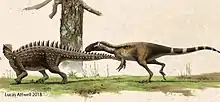 Emausaurus attacked by a theropod | |
Plantae
Coals
.jpg.webp)
The Łęka Coal Basin has been known since 1800 for its abundant deposits; younger material has been suggested as redeposited from the Paleozoic, but the basin primarily yields a series of Pliensbachian-Toarcian coals. In the Early Jurassic the Blanowice Formation was surrounded by land on the north, east and south, the source of sediment which was deposited as nearshore coal. This coal is abundant in the upper part of the formation, dominated by alluvial and lacustrine sand and coal-bearing sediments.[104] Organic matter associated with the coal includes the oldest known biomolecules (in the Mrzygłód clay-pit), composed of labdanoic acid, ferruginol, sugiol and 7-oxototarol.[104] The extracted samples were recovered at the Wysoka Lelowska 47Ż and Jaworznik 124Ż boreholes; five core samples were taken from the Żarki 90Ż core, the latter from an approximately 1.5-metre (4 ft 11 in) coal seam.[104] The random reflectance (%Rr) of the coals is 0.47–0.56, indicating sub-bituminous coal.[104] The geochemical data suggest low-maturity sediments,[104] and hopane isomers are relatively high in all samples.[104] This is confirmed by unstable biomolecules in the coal samples, including labdanoic acid, ferruginol, sugiol, oxototarol, beta-sitosterol and cholesterol.[104]
The coals are generally dominated by vitrinite macerals, except for a high percentage of inertinite. This indicates wildfires or peat fires, confirmed by charcoal fragments.[104] Sesquiterpenes and diterpenes, common in conifers, angiosperms and bryophytes, were also recovered from the coal.[105] Vitrinite has a reflectance value of 0.49-0.56 %Ro. The cupressaceae and podocarpaceae families are considered the main peat-forming plant species, due to the presence of phenolic abietanes and dehydroabietic acids.[104] Lignite indicates significant benzohopane derivatives in the surrounding sandstones, probable differences in biodegradation, and a typically low coalification range.[106] Later, larger studies note the influence of fires on the region.[107]
The Kaszewy coals, found in an approximately 150-metre (490 ft) section of terrestrial and marine siliciclastic sediments in the Kaszewy-1 and Niekłan PIG-1 boreholes, are the Ciechocinek Formation's major coals.[107] This section was in a nearshore-deltaic setting, with increased terrestrial and marine organic matter reflecting increased weathering and transport of terrestrial matter.[107] Abundant fossil charcoal and polycyclic aromatic hydrocarbons have been found. The number of coarse fossil charcoal particles (larger than 125 micrometers) in the Pliensbachian-Toarcian sections of the Kaszewy-1 core is very low (0-15 particles/10 g sediment), and fine charcoal particles (<125 μm) are more abundant (~12,000–256,000 particles/10 g sediment); there are also more non-charcoal particles.[107] There are more fine charcoal particles at the beginning of the Toarcian, reflecting environmental changes. In the polycyclic aromatic hydrocarbons, the pyrolytics (benz-anthracene, benzo(k)fluoranthene, fluoranthene, indeno[1,2,3-cd]pyrene, phenanthrene and pyrene) were detected in a wide variety of samples; phenanthrene is the most abundant component and coronene the least, suggesting the burning of organic matter.[107] Petrogenics are more abundant on the coal samples than pyrolytics, suggesting low wildfire activity.[107] Although the Kaszewy-1 borehole did not indicate increased wildfire activity, the fine fossil-charcoal abundance and pyrolytic concentration indicate regional wildfires.[107] Pyrolytics indicating the increased wildfire activity match the beginning of the Toarcian anoxic event, with intervals of fewer wildfires.[107] Wildfire changes match the Lower Toarcian negative carbon-isotopes emissions measured on the, which probably promoted a rise in atmospheric oxygen. Some questions remain; the climate was warmer and wetter (which can suppress wildfire activity), and wildfires persisted in the Kazewy-1 borehole wildfire activity was successfully sustained.[107] Wildfires may have subsided due to a lack of suitable fuel.[107]
Biomass
Beyond proper palynogy, biomass associated has been recovered, specially on the Brody-Lubenia borehole, with abundance of C29 diasterenes (>70%), that proves a great contribution of land plants and thus terrestrial deposits nearby.[108] There is also in some levels abundance of algae-derived C27 and C28 diasterenes, coeval with acritachs, prasinophytes and dinoflagellates, being this last ones important primary producers in the Polish Basin.[108] The presence of C27 sterols points to the importance of the dinoflajellates, but also other groups, such as Bangiophyceae and Eustigmatophyceae algae or marine protists like the Thraustochytriaceae.[108] At Parkoszowice in parasequences “b” to “f” an increase of C27 and C28 diasterenes, that can be interpreted to reflect enhanced biomass contribution from aquatic algae groups, but may also reflect a decline in land plant contributions. At least in some facies there is evidence of proliferation of freshwater-tolerant algae in the brackish environments of the Polish Basin.[108] As well the samples have provided the evidence of methane oxidizers from wetlands, whose emissions contribute to the early Toarcian carbon cycle perturbation.[108]
Resins
| Type | Location | Material | Notes | Images |
|---|---|---|---|---|
|
Fossil Resin[104] |
|
|
The local Resins containing sesqui-and diterpenoids that are produced by species of all contemporary conifer families, and in especially large amounts by Pinaceae, Cupressaceae, and Araucariaceae. The linked occurrence of inertinite, charcoal fragments, etc. show local Pliensbachian/Toarcian wildfires and/or peat fires.[104] |
.jpg.webp) Extant Cupressaceae Resin, the Blanowice coals resins probably come from a similar Conifer |
Megaspores
Polish Lower Toarcian palynology is assigned to the Paxillitriletes phyllicus (Ph) level (Isoetales), due to the abundance of this genus.[109] The lower part of the Toarcian level has numerous occurrences of this species, sometimes before the genera Erlansonisporites sparassis (Selaginella-like) and Minerisporites volucris (Isoetaceae) in the Gorzów Wlkp. IG 1 borehole.[109] The upper part contains less of the genus.[109] The most common species found on Poland in this era include Erlansonisporites sparassis, E. excavatus, Minerisporites volucris and Biharisporites scaber (Lycopodiopsida); Aneuletes potera and Trileites murrayi (both Selaginella) are found on the upper levels.[109] The Toarcian disturbance of the carbon cycle recorded on the Ciechocinek Formation, coincides roughly with the appearance of Paxillitriletes phyllicus. The type of dominant palynomorphs recovered changed from pollen grains during the Upper Pliensbachian to megaspores, indicating a climatic change from moderate and relatively dry to warm and humid in the early Toarcian.[109] This shift in local climate correlates with a global maritime transgression in which volcanism in the Karoo-Ferrar large igneous provinces raised the global temperature and disrupted the carbon cycle, creating a major greenhouse effect.[109] The prevalence of megaspore Paxillitriletes phyllicus correlate with warmth and humidity; the flora, dominated by the family Isoetaceae, requires standing water to reproduce.[109] The megaespore Paxillitriletes phyllicus then drops significantly, indicating a return to a more moderate climate during sedimentation of the younger Borucice Formation.[109]
Bryophyta
| Genus | Species | Stratigraphic position | Material | Notes | Images |
|---|---|---|---|---|---|
|
|
|
Affinities with Sphagnopsida inside Sphagnales. Spores nearly identical to that one found associated with the modern moss genus Sphagnum. Moss related to high humid environments. |
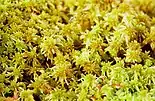 Extant Sphagnum, the typical example of the Sphagnales. Rogalskaiporites probably come from a similar Plant | |
|
Cingulatisporites[111] |
|
|
|
Affinities with Anthocerotaceae (specially Phaeoceros, Megaceros) inside Bryophyta. Moss spores from humid settings |
_1077.JPG.webp) Extant Phaeoceros, whose spores are similar to the extinct Cingulatisporites |
|
Cirratriradites[111] |
|
|
|
Affinities with Anthocerotaceae inside Bryophyta. Moss spores from humid settings |
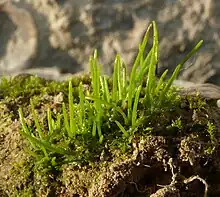 Extant Anthoceros, the typical example of the Anthocerotaceae. Cirratriradites probably come from a similar Plant |
|
Foraminisporis[112] |
|
|
| ||
Lycophyta
| Genus | Species | Stratigraphic position | Material | Notes | Images |
|---|---|---|---|---|---|
|
|
|
Affinities with Lycopodiaceae inside Lycopodiopsida, but also Lepidodendraceae. Reworked from Carboniferous layers |
||
|
|
| |||
|
Hymenozonotriletes[114] |
|
|
| ||
|
|
| |||
|
|
|
Affinities with the Chaloneriaceae inside Lycopsida. Valvisisporites and Endosporites formed a sig- nificant component of the sporae dispersae flora in Upper Carboniferous and Pennsylvanian coals of the Northern Hemisphere |
||
|
Crassispora[111] |
|
|
|
Affinities with Sigillariaceae, Sigillariostrobaceae and Lepidodendraceae inside Lycophyta. Rworked from Carboniferous layers. Arboreal Lycopites |
|
|
|
| |||
|
|
|
Affinities with Lycopodiaceae inside Lycopodiopsida. Resemble spores of the modern genus Lycopodium. If it belongs to a similar genus, represent low herbaceous flora spores. |
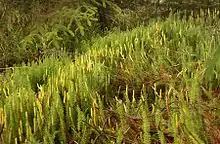 Extant Lycopodium, typical example of Lycopodiaceae. Lycopodiumsporites probably come from a similar or a related Plant | |
|
|
| |||
|
Biharisporites[116] |
|
|
| ||
|
|
|
Affinities with the Isoetales inside Lycophyta. Spores related to modern Isoetes, representing Small plants related to water bodies. Paxillitriletes comprises the main Megaspore zonation of the Toarcian of Poland, being the most abundant spore found on the Ciechocinek Formation, and the genus that marks the start of the strata. The Abundance of this genus along with Minerisporites institus points to very humid conditions during almost the entire T-OAE, upwards from CIE step 2 of the carbon isotope curves. |
| |
|
|
| |||
|
|
| |||
|
|
|
Affinities with the Selaginellaceae inside Lycopsida. Herbaceous Lycophyte flora, similar to Ferns, ralated with Humid Settings. This Family of Spores are also the most diverse on the Formation. |
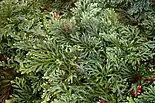 Extant Selaginella, typical example of Selaginellaceae, the Spore found in the Ciechocinek Fm probably come from a similar or a related Plant | |
|
|
| |||
|
|
| |||
|
|
| |||
|
|
spores | |||
|
|
| |||
|
|
| |||
|
|
| |||
|
|
| |||
|
|
| |||
|
Bacutriletes[111] |
|
|
| ||
|
|
|
Affinities with Pleuromeiales inside Lycophyta. The Plueromeiales were tall Lycophites (2 to 6 m) common on the Trassic. Probably come from a relict genus. |
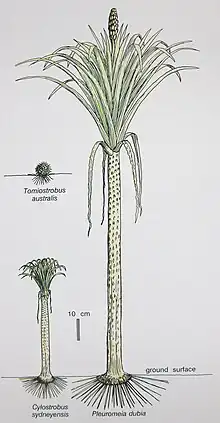 Reconstruction of the extinct genus Pleuromeia, typical example of Pleuromeiales. Nathorstisporites probably come from a similar or a related Plant | |
|
Margaritatisporites[111] |
|
|
| ||
Equisetidae
| Genus | Species | Stratigraphic position | Material | Notes | Images |
|---|---|---|---|---|---|
|
Asterocalamotriletes[111] |
|
|
|
Affinities with Asterocalamitopsida inside Equisetopsida. Reworked from Palaeozoic horsetails Asterocalamites and Stigmatocanna. |
|
|
Florinisporites[111] |
|
|
|
Affinities with Equisetopsida inside Equisetopsida. Found only on Poland. |
.JPG.webp) Extant Equisetum cone, the typical example of the Equisetopsida. Florinisporites spores are pretty similar to the extant ones |
|
Irrimales[111] |
|
|
| ||
Filicopsida
| Genus | Species | Stratigraphic position | Material | Notes | Images |
|---|---|---|---|---|---|
|
|
|
Incertae Sedis affinities with the Pteridophyta. Uncertain Pteridophyte origin |
||
|
|
| |||
|
|
| |||
|
|
|
Affinities with the Botryopteridaceae inside Filicopsida. Reworked from primitive ferns found in Devonian and Carboniferous rocks of Europe |
||
|
|
|
Affinities with the Schizaeaceae inside Schizaeales. Represents large spores from herbaceous ferns, that are more abundant on the south of the Toarcian polish basin than on the north. |
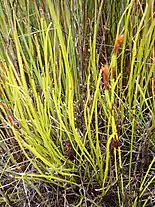 Extant Schizaea, typical example of the Schizaeaceae. Klukisporites spores are pretty similar to the extant ones of this genus | |
|
|
| |||
|
Undulatisporites[112] |
|
|
|
Affinities with the Anemiaceae inside Schizaeales. |
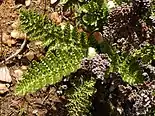 Extant Anemia caffrorum, typical example of the Anemiaceae. Undulatisporites spores are pretty similar to the extant ones of this genus |
|
|
|
Affinities with the Aspleniaceae inside Filicopsida. |
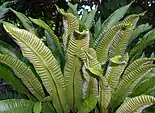 Extant Asplenium, typical example of the Aspleniaceae | |
|
Laevigatosporites[111] |
|
|
|
Affinities with the Blechnaceae inside Filicopsida. |
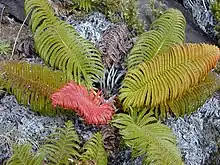 Extant Sadleria, typical example of the Blechnaceae. Laevigatosporites spores are pretty similar to the extant ones of this genus |
|
Dennstaedtiites[111] |
|
|
Spores |
Affinities with Dennstaedtiaceae inside Pteridophyta. Floor Herbaceous ferns, probably from covered forest areas. |
.jpg.webp) Extant Pteridium aquilinum, typical example of the Dennstaedtiaceae. Dennstaedtiites spores are pretty similar to the extant ones of this genus |
|
|
Spores | |||
|
Baculatisporites[111] |
|
|
Spores |
Affinities with the family Osmundaceae inside Polypodiopsida. Near Fluvial currents ferns, reted to the modern Osmunda Regalis. |
_-_Cape_St._Mary's_Ecological_Reserve%252C_Newfoundland_2019-08-10.jpg.webp) Example of extant Osmunda specimens, Baculatisporites and Todisporites come probably from similar genera or maybe a species from the genus |
|
Todisporites[111] |
|
|
Spores | ||
|
|
Spores | |||
|
|
|
Affinities with the Marsileaceae inside Salviniales. Represents spore from fully aquatic ferns, found associated with fluvial or deltaic deposits, where probably formed large underwater colonies. |
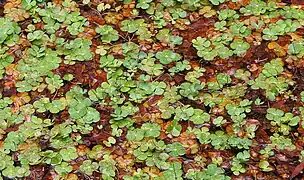 Extant Marsilea, typical example of the Marsileaceae. Crybelosporites may have come from a similar genus | |
|
|
|
Affinities with the Gleicheniaceae inside Polypodiidae. Resemble the modern Gleichenia Spores, and probably represent a similar genus or a member of it. Fern related to large colonies, found mostly on humid environments. |
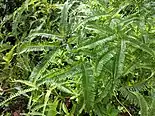 Extant Unidentified Gleicheniaceae. Gleicheniidites may have come from a similar genus | |
|
|
|
Affinities with the Marattiaceae inside Polypodiidae. Resemble the modern Marattia spores, probably belonging to a similar genus, related with large sized herbaceous ferns of humid environments. |
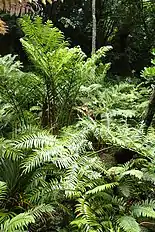 Extant Marattia, typical example of the Marattiaceae. Marattisporites may have come from a similar genus | |
|
|
|
Affinities with the Matoniaceae inside Polypodiidae. The so-called comb-ferns, found forming large colonies on humid settings. |
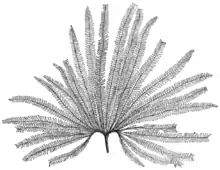 Extant Matonia, typical example of the Matoniaceae. Matonisporites may have come from a similar genus | |
|
Cardioangulina[112] |
|
|
| ||
|
|
Spores |
Affinities with Cyatheaceae inside Cyatheales. Cyathidites minor almost certainly belong to well known Mesozoic species Coniopteris hymenophylloides and to other fossil cyatheaceous or dicksoniaceous ferns such as Eboracia lobifolia and Dicksonia mariopteri. |
_(14820801765).jpg.webp) | |
|
Maculatisporites[112] |
|
|
Spores | ||
|
|
| |||
|
|
|
Affinities with the genus Dicksoniaceae inside Polypodiopsida. Tree fern spores |
_C.Chr._by_Jason_Hollinger_001.jpg.webp) Example of extant Lophosoria specimens | |
Cycadeoidophyta
| Genus | Species | Stratigraphic position | Material | Notes | Images |
|---|---|---|---|---|---|
|
Bennettitinae[111] |
|
|
|
Affinities with Bennettitinae the inside Bennettitales. Very abundant Pollen. |
|
|
|
|
Affinities with the Cycadeoidaceae inside Bennettitales. |
||
|
|
|
Affinities with Williamsoniaceae the inside Bennettitales. Very abundant Pollen. |
 Reconstruction of Williamsonia, typical example of the Williamsoniaceae. Bennetistemon Pollen is considered to come from a similar genus | |
|
|
Pollen |
Affinities with the family Zamiaceae inside Cycadales. Is among the most abundant flora recovered on the upper section of the coeval Rya Formation, and was found to be similar to the pollen of the extant Encephalartos laevifolius.[120] |
 Extant Encephalartos laevifolius. Chasmatosporites maybe come from a related plant | |
|
|
|
Affinities with the family Cycadaceae inside Cycadales. The structure of the exine of Clavatipollenites hughesii from Jurassic deposits is fundamentally different from that of Cretaceous grains referred to the same species, confirming observations made previously on the basis of analysis under the light microscope, and suggesting a possible derivation from cycadalean rather than angiospermous plants.[121] |
 Extant Cycas platyphylla. Clavatipollenites maybe come from a related plant | |
|
Cycadopites[112] |
|
|
| ||
|
Cycadopollenites[112] |
|
|
| ||
Gnetophyta
| Genus | Species | Stratigraphic position | Material | Notes | Images |
|---|---|---|---|---|---|
|
|
|
Type Pollen of the Erdtmanithecales, that can be related with the Gnetales. Thick tectum, infratectum of small granules, indistinct or absent foot layer. Originally was thought to come from Angiosperms, latter reports suggest it come from arbustive Bennetites. It was recently found to come from Eucommiitheca, member of the enigmatic Erdtmanithecales, reinterpreted as an unusual gymnosperm grain with a single distal colpus flanked by two subsidiary lateral colps. Is very similar to the Pollen of the extant Ephedra and Welwitschia (mainly on the granular structure of the exine).[122] |
||
Gnetophyta
| Genus | Species | Stratigraphic position | Material | Notes | Images |
|---|---|---|---|---|---|
|
Ginkgocycadophytus[112] |
|
|
|
Affinities with the family Karkeniaceae and Ginkgoaceae in Ginkgoales. Monosulcites was initially mistaken as Pollen coming from early Agiosperms, yet is likely from Ginkgoales |
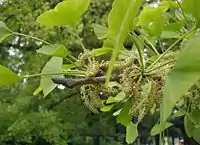 Extant Ginkgo, only surviving example of the Ginkgoaceae. Ginkgocycadophytus Pollen is pretty similar to the extant ones of this genus |
|
Monosulcites[123] |
|
|
Pollen | ||
Coniferophyta
| Genus | Species | Stratigraphic position | Material | Notes | Images |
|---|---|---|---|---|---|
|
|
|
Affinities with Utrechtiaceae and Voltziales inside Coniferae. Primitive Conifer and possible relict taxon |
||
|
|
|
Affinities with Cordaitaceae inside Coniferae. Reworked from Permian layers |
||
|
|
|
Affinities with Paleoconiferae inside Coniferae. Primitive Conifer and possible relict taxon |
||
|
Protoabies[111] |
|
|
| ||
|
Pseudopinus[111] |
|
|
| ||
|
|
|
Affinities with the Patokaeaceae inside Coniferae. Pollen of the Conifer Patokaea silesiaca, know only from the Polish Upper Triassic (Norian) locality in Patoka.[124] |
||
|
|
|
Affinities with the Araucariaceae or Pinaceae inside Coniferae. |
||
|
|
|
Affinities with both Sciadopityaceae and Miroviaceae inside Pinopsida. This Pollen resemblance with extant Sciadopitys suggest that Miroviaceae can be an extinct lineage of sciadopityaceaous-like plants.[125] |
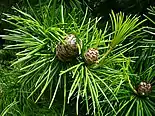 Extant Sciadopitys. Cerebropollenites likely come from a related plant | |
|
|
|
Affinities with the family Pinaceae inside Pinopsida. Conifer pollen from medium to large arboreal plants |
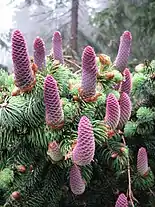 Extant Tsuga Cone, example of the Abietoideae. Pinaceae Pollen of the Ciechocinek fm is similar to the pollen found on this genus, hence the name | |
|
Abietineaepollenites[123] |
|
|
Pollen | ||
|
|
Pollen | |||
|
|
| |||
|
|
| |||
|
Rotundipollenites[113] |
|
|
| ||
|
|
| |||
|
|
|
Affinities with the Podocarpaceae inside Pinopsida. Conifer pollen from medium to large arboreal plants |
.jpg.webp) | |
|
|
| |||
|
|
Pollen | |||
|
|
|
Affinities with the Cheirolepidiaceae inside Coniferae. Is very abundant on hot and dry settings, found specially on the Brody-Lubienia Borehole. |
||
|
Sphaeripollenites[112] |
|
|
| ||
|
|
|
Affinities with the Cupressaceae inside Coniferae. The Pollen from this genus is similar to the present on the modern Fitzroya and Calocedrus. |
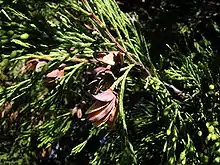 Extant Calocedrus Cone, example of the Cupressaceae. Cupressacites is similar to the pollen found on this genus | |
|
|
| |||
|
|
| |||
|
|
|
Affinities with the Araucariaceae inside Coniferae. Resemble the pollen from the modern genus Agathis. |
 Extant Agathis Cone, example of the Araucariaceae. Applanopsipollenites is similar to the pollen found on this genus | |
|
Applanopsis[123] |
|
|
| ||
|
|
Pollen | |||
Fossil Wood
The Blanowice Coals fossil wood from Zawiercie area were already described in 1917 as “Blanowicer Keuperholz”, on the basis of specimens from the “Elka”, “Kamilla” and “Zygmunt” coal pits, claimed to be xylologically similar, yet no taxon was named and the collection was not preserved.[126] Based on recent revisions of the local flora, likely belong to Agathoxylon.
| Genus | Species | Location | Material | Notes | Images |
|---|---|---|---|---|---|
|
|
|
Affinities with Hirmeriellaceae or Araucariaceae inside Pinales. |
||
Megaflora
The Lublin upland fluvial sandstones contain diverse fossil flora, associated genera and species with Lower Jurassic sediments. Carboniferous flora, similar to that of Jurassic formations, appeared in boreholes near the planned Bogdanka Coal Mine.[128] The age of the plant material was not determined until 2020, when it was identified as Lower Toarcian (with some Late Pliensbachian strata).[108] The Brody-Lubienia borehole is abundant in terrestrial palynomorphs and aquatic biomass.[108] The sediments from Brody-Lubienia have a more-terrestrial character, indicated by the frequent occurrence of plant roots and paleosol horizons;[108] moisture was probably fresh (not saline) water.[108] The environment was probably dry, developing flora near freshwater inflow from the east.[108]
The Lublin lias is dominated by cycads and Bennetites Ginkgoales. Ferns occur sporadically in the bottom of the Toarcian, where deposits are filled with coal, mudstone, sandstone and clay siderite (reworked from the Carboniferous) and pebbles from Devonian limestones.[129] Similar boreholes and nearby deposits indicate the end of a river which transported Devonian-Carboniferous deposits from the northeast to the aquatic inland environment.[129] Vegetation grew primarily outside the sedimentation area, on shores and in shallow water.[130]
At Ahrensburg there are plant remains in all horizons: wood, plant chaff and, in the Eleganticeras layers, nutty fruits, Araucariaceous cones, conifer branches, horsetail, etc.[20]
Equisetopsida
| Genus | Species | Stratigraphic position | Material | Notes | Images |
|---|---|---|---|---|---|
|
|
|
Affinities with Equisetaceae inside Equisetales. Found in a layer associted with Coniferous wood |
||
|
Schizoneura[131] |
|
|
|
Affinities with Equisetales inside Equisetopsida. This genus is rather scarce compared with other coeval Equisetalean fossils |
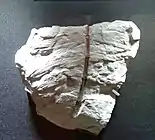 |
|
|
|
Affinities with Calamitaceae inside Equisetopsida. A common horsetail on the Liassic of Europe. . |
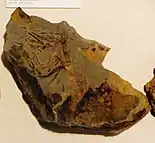 | |
Pteridospermatophyta
| Genus | Species | Stratigraphic position | Material | Notes | Images |
|---|---|---|---|---|---|
|
|
Pinnae |
Affinities with the Peltaspermales inside Pteridospermatophyta. Bipinnate leaves, rachis longitudinally striated, with a long petiole and secondary rachises inserted oppositely to suboppositely on the upper side of the primary rachis. This Leaves belong to large Aboreal Ferns related with dry environments. |
||
|
|
Pinnae |
Affinities with the Umkomasiaceae inside Pteridospermatophyta. Is very similar to Rhaphidopteris, characterized by usually bi-tripinnate, coriaceous leaves with narrow segments. It belongs to Large (up to 25 m tall) arboreal Fern-like plants. |
||
|
|
Ovulate Structure |
Affinities with the Caytoniaceae inside Caytoniales. Represents the Ovulate organs or large Tree ferns, and is related with the middle Jurassic flora of United Kingdom. |
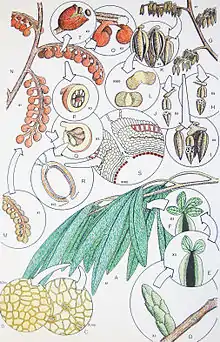 | |
|
|
Pinnae |
Affinities with the Caytoniaceae inside Caytoniales. Sagenopteris is most likely the Pinnae of the Tree Fern that also contain Caytonia. |
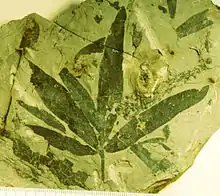 | |
Bennettitopsida
| Genus | Species | Stratigraphic position | Material | Notes | Images |
|---|---|---|---|---|---|
|
|
Pinnae |
Affinities with the Bennettitales inside Bennettitopsida. Anomozamites is characterised by slender, (almost) completely and regularly segmented leaves whose leaflets are generally as long as broad or, at maximum, two times as long as broad. This genus is related with more arboreal Bennetitalean flora. Shows coriaceous leaves and is a genus linked more with dry climates. |
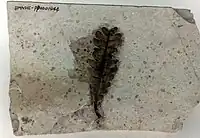 | |
|
|
Pinnae |
Affinities with the Bennettitales inside Bennettitopsida. A more arbustive type of Bennetite, abundant on the Pliensbachian-Toarcian strata along Eurasia, related to rather dry climates. |
.jpg.webp) | |
|
|
Pinnae |
Affinities with the Bennettitales inside Bennettitopsida. This Bennetite has a leaf similar to Nilssonia, large, lanceolate in outline with coriaceous structure, like the modern angiosperm Philodendron. Is related with rather Dry-hot environments, with less Fern flora. |
||
|
|
Pinnae |
Affinities with the Cycadeoidaceae inside Bennettitales. The most abundant plant macrofossil locally, and the most diverse found on the Lublin coals. It represents a Cycad Like plant with Coriaceous leaves. Is related by some botanists with the Bennetite branch that led to Angiosperms. |
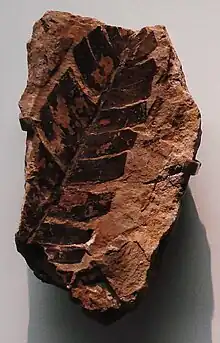 | |
|
Cycadolepis[133] |
|
|
Bennettitalean cone scales |
Affinities with the Cycadeoidaceae inside Bennettitales. |
|
|
|
Bennetite "Flower" |
Affinities with the Cycadeoidaceae inside Bennettitales. The Bennetite flowers are the main organ that links this relatives with the Cycas with modern Angiosperms. Probably the Pollen assigned to Angiosperms come from plants with this "Flowers". |
||
|
|
Pinnae |
Affinities with the Williamsoniaceae inside Bennettitopsida. Leaves from Arboreal Bennetites, similar to the modern Cyca Encephalartos woodii, with robust Trunks, built for Dry and hot climates. |
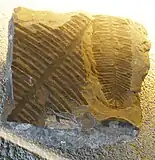 | |
Ginkgoidae
| Genus | Species | Stratigraphic position | Material | Notes | Images |
|---|---|---|---|---|---|
|
|
Leaves |
Affinities with the Ginkgoaceae inside Ginkgoidae. Linked to the Hettangian-Sinemurian flora from Greenland and Skane, but also with coeval flora from the Sorthat Formation. Is the main Tree flora recovered locally. |
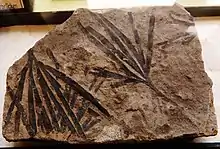 | |
|
|
Cuticles |
Affinities with the Ginkgoaceae inside Ginkgoidae. Associated with relatively warmer and humid conditions. |
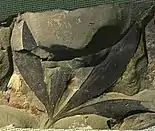 | |
|
|
Cuticles |
Affinities with the Ginkgoaceae inside Ginkgoidae. Associated with relatively warmer and humid conditions. |
||
Coniferophyta
| Genus | Species | Stratigraphic position | Material | Notes | Images |
|---|---|---|---|---|---|
|
|
Ovuliferous cones |
Affinities with the Cheirolepidiaceae inside Pinales. The type Leave from the Cheirolepidaceae family (as Cheirolepis, the genus that give name to the family, is a junior synonym), appears to be linked with Hot climates, able to survive in dry, extreme conditions, and been fire tolerant. |
||
|
|
Terminal leafy shoot fragments |
Affinities with the Cheirolepidiaceae or Araucariaceae inside Pinales. This species is only known from the Middle Jurassic of Wildtshire. |
||
|
|
|
Affinities with Araucariaceae or Hirmeriellaceae inside Pinales. |
 Example of Pagiophyllum specimen | |
References
- Pietrzeniuk, E. (1961). "Zur Mikrofauna einiger Liasvorkommen der Deutschen Demokratischen Republik" (PDF). Freiberger Forschungshefte. 21 (5): 113–129. Retrieved 4 November 2021.
- Kopik, J. (1960). "Mikropaleontologiczna charakterystyka liasu dolnego doggeru Polski". Geological Quarterly. 4 (4): 921–935. Retrieved 21 December 2021.
- Kopik, J.; Marcinkiewicz, T. (1997). "Jura dolna: Biostratygrafia". The epicontinental Permian and Mesozoic in Poland (In Polish with English summary). Prace Paƒstwowego Instytutu Geologicznego. 153 (1): 196–205.
- Kopik, J. (1998). "Lower and Middle Jurassic of the north-eastern margin of the Upper Silesian Coal Basin". Biuletyn Państwowego Instytutu Geologicznego. 378 (1): 67–129.
- Jurkiewiczowa, I. (1967). "Lias zachodniego obrzeżenia Gór Świętokrzyskich i jego paralelizacja z liasem Wyżyny Krakowsko-Częstochowskiej" (PDF). Biul. Inst. Geol. 200 (1): 5–132. Retrieved 1 January 2022.
- Osika, R. (1958). "Profil górnego liasu i doggeru okolic Złotowa". Geological Quarterly. 2 (4): 765–784. Retrieved 21 December 2021.
- Barski, M.; Leonowicz, P. (2002). "Dinoflagellates of Lower Jurassic outcrops at Kozłowice and Boroszów (southern Poland)". Przegląd Geologiczny. 50 (5): 411–414. Retrieved 21 December 2021.
- Pieńkowski, G; Hodbod, M.; Ullmann, C. V (2016). "Fungal decomposition of terrestrial organic matter accelerated Early Jurassic climate warming". Scientific Reports. 6 (1): 31930. Bibcode:2016NatSR...631930P. doi:10.1038/srep31930. PMC 4995404. PMID 27554210.
- Rogalska, M. (1954). "Spore and pollen analysis of the Liassic Coal of Blanowice in Upper Silesia [ Analyza sporowo-pylkowa Liasowego Wegla Blano-Wickiego z Gornego Slaska ]". Biuletyn - Instytutu Geologiczny. 89 (1): 1–46.
- Geinitz, F. E. (1880). "Der Jura von Dobbertin in Mecklenburg und seine Versteinerungen" (PDF). Zeitschrift der Deutschen Geologischen Gesellschaft. 32 (1–2): 510–535. Retrieved 14 November 2021.
- Suhr, P. (1988). "Lebensspuren aus dem Lias von Dobbertin". Fundgrube. 24 (1): 22–26.
- Stumpf, Sebastian; Ansorge, Jörg; Grimmberger, Gunther (2016). "Grätensandsteine und andere Geschiebe des oberen Lias (Toarcium) aus Norddeutschland [Upper Liassic sandstones with fish remains (so-called Grätensandsteine) and other Toarcian glacial erratics from northern Germany]". Geschiebekunde Aktuell. 32 (4): 121–141. Retrieved 30 July 2021.
- Leonowicz, P. (2008). "Trace fossils from the Lower Jurassic Ciechocinek Formation, SW Poland". Volumina Jurassica. 6 (6): 89–98. Retrieved 21 December 2021.
- Leonowicz, P. M. (2016). "Tubular tempestites from Jurassic mudstones of southern Poland". Geological Quarterly. 60 (2): 385–394. Retrieved 21 December 2021.
- Czapowski, G.; Dadlez, R.; Feldman-Olszewska, A.; Gortyńska, S.; Jaskowiak-Schoeneichowa, M.; Kasiński, J.R.; Znosko, J. (2014). "Szczegółowy profil litologiczno-stratygraficzny: Gorzów Wielkopolski IG" (PDF). Polska Bibliografia Naukowa. 144 (1): 1–378. Retrieved 21 December 2021.
- Marcinkiewicz, T. (1971). "The stratigraphy of the Rhaetian and Liasin Poland based on megaspore investigations [ Stratygrafia Retyku i Liasu w Polsce na Podstawie badan megasporowych. ]". Prace Instytut Geologiczny,(Warsaw). 65 (1): 1–57.
- Manum, S.B.; Bose, M.N.; Sawyer, R.T. (1992). "Seeds (Burejospermum Krassilov) and palynomorphs (Dictyothylakos Horst) with a netted wall structure reinterpreted: Clitellate cocoons". Courier Forschungsinstitut Senckenberg. 147 (1): 399–404. Retrieved 21 December 2021.
- Ernst, W. (1967). "Die Liastongrube Grimmen. Sediment, Makrofauna und Stratigraphie". Ein Überblick Geologie. 16 (1): 550–569.
- Denckmann, A. (1887). Ueber die geognostischen Verhältnisse der Umgegend von Dörnten nördlich Goslar: mit besonderer Berücksichtigung der Fauna des oberen Lias (Vol. 8, No. 2). Berlin: Schropp. Retrieved 22 October 2021.
- Lehmann, U. (1968). "Stratigraphie und Ammonitenführung der Ahrensburger Glazial-Geschiebe aus dem Lias epsilon (Unt. Toarcium)" (PDF). Mitteilungen aus dem Geologischen Staatsinstitut in Hamburg. 37 (2): 41–68. Retrieved 29 December 2021.
- Zessin, W. (2010). "The Dobbertine Jura (Lias ε, Mecklenburg) and its importance for paleoentomology" (PDF). Virgo, Newsletter of the Entomological Association Mecklenburg. 13 (1): 4–9. Retrieved 8 September 2021.
- Geinitz, F. E. (1884). "Ueber die Fauna des Dobbertiner Lias" (PDF). Zeitschrift der Deutschen Geologischen Gesellschaft Band. 36 (3): 566–583. Retrieved 8 September 2021.
- Hesselbo, S.P.; Pieńkowski, G. (2011). "Stepwise atmospheric carbon-isotope excursion during the Toarcian oceanic anoxic event (Early Jurassic, Polish Basin)". Earth and Planetary Science Letters. 301 (1–2): 365–372. Bibcode:2011E&PSL.301..365H. doi:10.1016/j.epsl.2010.11.021. Retrieved 21 December 2021.
- Ernst, W. (1992). "Der Lias der Scholle von Dobbertin (Mecklenburg)". Fundgrube. 28 (1): 56–70.
- Sachs, S.; Hornung, J. J.; Lierl, H. J; Kear, B. P. (2016). "Plesiosaurian fossils from Baltic glacial erratics: evidence of Early Jurassic marine amniotes from the southwestern margin of Fennoscandia". Geological Society, London, Special Publications. 434 (1): 149–163. Bibcode:2016GSLSP.434..149S. doi:10.1144/SP434.14. S2CID 130195351.
- Hoffmann, K.; Martin, G. P. (1960). "Die Zone desDactylioceras tenuicostatum (Toarcien, Lias) in NW-und SW-Deutschland". Paläontologische Zeitschrift. 34 (2): 103–149. doi:10.1007/BF02987046. S2CID 129436561.
- Schlögl, J.; Košt'ák, M.; Hyžný, M. (2015). "First record of a gladius-bearing coleoid Teudopsis bollensis Voltz (Cephalopoda, Coleoidea) in the Toarcian of the Western Carpathians (Slovakia)". Paläontologische Zeitschrift. 86 (4): 367–375. doi:10.1007/s12542-012-0139-z. S2CID 129370764. Retrieved 30 July 2021.
- Ansorge, J. (2007). "Lower Jurassic clay pit of Klein Lehmhagen near Grimmen. The Central European Basin System–from the Bottom to the Top". Geo-Pomerania, Szczechin. 23 (1): 37–41. Retrieved 8 September 2021.
- Leonowicz, P. (2011). "Sedimentation of Lower Toarcian (Lower Jurassic) brackish deposits from the Częstochowa-Wieluń region (SW Poland)". Acta Geologica Polonica. 61 (2): 215–241. Retrieved 21 December 2021.
- Areń, B. (1965). "Wyniki wiercenia Warszawa IG-1". Przegląd Geologiczny. 13 (9): 369. Retrieved 2 January 2022.
- Jurkiewicz, H. (1965). "Profil wiercenia w Bożej Woli". Przegląd Geologiczny. 13 (9): 378. Retrieved 2 January 2022.
- Stemulak, J. (1957). "Komunikat o wierceniu Płońsk 1". Geological Quarterly. 1 (2): 268–274. Retrieved 2 January 2022.
- Selden, Paul A.; Dunlop, Jason A. (2014). "The first fossil spider (Araneae: Palpimanoidea) from the Lower Jurassic (Grimmen, Germany)". Zootaxa. 3894 (1): 161–168. doi:10.11646/zootaxa.3894.1.13. PMID 25544628. Retrieved 30 July 2021.
- Ansorge, J. (2003). "Insects from the Lower Toarcian of Middle Europe and England". Proceedings of the Second Palaeoentomological Congress, Acta Zoologica Cracoviensia. 46 (1): 291–310. Retrieved 30 July 2021.
- Handlirsch, A. (1906). "Die Fossilen Insekten und die Phylogenie der Rezenten Formen, parts I-IV". Ein Handbuch für Paläontologen und Zoologen. 12 (1): 1–640.
- Ansorge, J. (1996). "Insekten aus dem oberen Lias von Grimmen (Vorpommern, Norddeutschland)". Neue Paläontologische Abhandlungen. 2 (1): 1–132. Retrieved 23 October 2021.
- Zessin, W. (1991). "Die Phylogenie der Protomyrmeleontidae unter einbeziehung neuer Oberliassischer funde (Odonata: Archizygoptera sens. nov.)". Odonatologica. 20 (1): 97–126. Retrieved 23 October 2021.
- Handlirsch, A. (1920). "Palaeontologie. I". N C. Schröder (Ed.), Handbuch der Entomologie. 3 (1): 117–208.
- Ansorge, J. (2000). "Identity of Prosepididontus calopteryx HANDLIRSCH 1920 (Insecta: Grylloblattida: Geinitziidae)". Acta Geológica Hispánica. 35 (1–2): 19–23. Retrieved 23 October 2021.
- Handlirsch, A. (1939). "Neue Untersuchungen u ̈ber die fossilen Insektenmit Erga ̈nzungen und Nachtra ̈gen sowie Ausblicken auf phylogenetische, palaeogeographische und allgemeine biologische Probleme. II Teil". Annalen des Naturhistorischen Museums in Wien. 49 (1): 1–240.
- Zessin, W. (1982). "Durchsicht einiger liassischer Odonatopteroida unter Berücksichtigung neuer Funde von Dobbertin in Mecklenburg". Deutsche Entomologische Zeitschrift. 29 (1): 101–106. doi:10.1002/mmnd.19820290117.
- Zessin, W.; Ansorge, J. (1987). "Magnasupplephlebia intercalaria n. sp.‐eine neue Anisozygopterenart aus dem oberen Lias von Mitteleuropa (Insecta, Odonata)". Deutsche Entomologische Zeitschrift. 34 (4‐5): 383–386. doi:10.1002/mmnd.19870340416. Retrieved 23 October 2021.
- Handlirsch, A. (1921). "Palaeontologie". In C. Schröder (Ed.), Handbuch der Entomologie. 3 (1): 209–304.
- Ansorge, J. (2004). "Insekten aus Liasgeoden der Ahrensburger Geschiebesippe" [Insects from the Lias nodules of the Ahrensburg geschiebe assemblage]. Archiv für Geschiebekunde (in German). 3 (1): 8. Retrieved 16 July 2021 – via ResearchGate.
- Ansorge, J. (1993). "Dobbertiniopteryx capniomimus gen. et sp. nov. die erste Steinfliege (Insecta: Plecoptera) aus dem europäischen Jura". Paläontologische Zeitschrift. 67 (3–4): 287–292. doi:10.1007/BF02990281. S2CID 130530628. Retrieved 23 October 2021.
- Zessin, W. (1987). "Variabilität, Merkmalswandel und Phylogenie der Elcanidae im Jungpaläozoikum und Mesozoikum und die Phylogenie der Ensifera". Deutsche Entomologische Zeitschrift. 34 (1–3): 1–76. doi:10.1002/mmnd.19870340102.
- Zessin, W. (1988). "Neue Saltatoria (Insecta) aus dem Oberlias Mitteleuropas". Freiberger Forschungshefte. 419 (1): 107–121.
- Zessin, W. (1983). "Revision der mesozoischen Familie Locustopsidae unter Berücksichtigung neuer Funde (Orthopteroida, Caelifera)". Deutsche Entomologische Zeitschrift. 30 (2): 173–237. doi:10.1002/mmnd.19830300115.
- Zessin, W. (1983). "Locustopsis kruegeri n. sp. (Orthopteroida, Caelifera) aus dem oberen Lias von Schandelah bei Braunschweig (BRD)". Zeitschrift für Geologische Wissenschaften. 11 (1–4): 905–910.
- Zeuner, F. E. (1939). Fossil Orthoptera Ensifera. London: BM(NH). pp. 1–321.
- Vršanský, P.; Ansorge, J. (2007). "Lower Jurassic cockroaches (Insecta: Blattaria ) from Germany and England". African Invertebrates. 48 (1): 103–126. Retrieved 23 October 2021.
- Wendt, A. (1940). "Liasocoris hainmülleri n. sp., eine fossile Wanze aus Mecklenburg". Archiv des Vereins der Freunde der Naturgeschichte in Mecklenburg. Neue Folge. 15 (1): 18–20.
- Popov, Y. A. (1992). "Jurassic bugs (Hemiptera: Heteroptera) from the Museum of Natural History in Vienna". Annalen des Naturhistorischen Museums in Wien. 94 (2–5): 7–14.
- Popov, Y. A.; Wootton, R. J. (1977). "The upper Liassic Heteroptera of Mecklenburg and Saxony". Systematic Entomology. 2 (3): 333–351. doi:10.1111/j.1365-3113.1977.tb00382.x. S2CID 84814736.
- Rasnitsyn, A. P.; Ansorge, J.; Zhang, H. C. (2006). "Ancestry of the orussoid wasps, with description of three new genera and species of Karatavitidae (Hymenoptera = Vespida: Karatavitoidea stat. nov.)". Insect Systematics & Evolution. 37 (3): 179–190. doi:10.1163/187631206788831137. Retrieved 23 October 2021.
- Rasnitsyn, A. P.; Ansorge, J.; Zessin, W. (2003). "New hymenopterous insects (Insecta: Hymenoptera) from the lower Toarcian (Lower Jurassic) of Germany". Neues Jahrbuch für Geologie und Paläontologie, Abhandlungen. 227 (1–3): 321–342. doi:10.1127/njgpa/227/2003/321.
- Ansorge, J.; Schlüter, T. (1990). "The earliest chrysopid: Liassochrysa stigmatica ng, n. sp. from the Lower Jurassic of Dobbertin, Germany". Neuroptera International. 6 (2): 87–93. Retrieved 23 October 2021.
- Jepson, J. E. (2015). "A review of the current state of knowledge of fossil Mantispidae (Insecta: Neuroptera)". Zootaxa. 3964 (4): 419–432. doi:10.11646/zootaxa.3964.4.2. PMID 26249453. Retrieved 23 October 2021.
- Geinitz, F. E. (1888). "Beitrag zur Geologie Mecklenburgs". Archiv des Vereins der Freunde der Naturgeschichte in Mecklenburg. 41 (4–6): 143–216.
- Makarkin, Vladimir; Ansorge, Jörg; V Khramov, Alexander (2021). "Revision of Epigambriinae Handlirsch, stat. nov., a subfamily of Early Jurassic Ithonidae s.l. (Neuroptera)". Palaeoentomology. 4 (6): 87–93. doi:10.11646/palaeoentomology.4.6.1. S2CID 245181387. Retrieved 16 December 2021.
- Makarkin, Vladimir N.; Ansorge, Jörg (2023). "The oldest dustywing (Neuroptera: Coniopterygidae) from the Lower Jurassic of Germany". PalZ: 12–23. doi:10.1007/s12542-023-00662-w. Retrieved 25 July 2023.
- Geinitz, F. E. (1894). "Die Käferreste des Dobbertiner Lias". Archiv des Vereins der Freunde der Naturgeschichte in Mecklenburg. 48 (1): 71–78.
- Kirejtshuk, A. G.; Ansorge, J. (2022). "An extraordinarily preserved new genus and species of Trachypachidae (Coleoptera, Adephaga) from the Early Jurassic of Germany and a review of fossil trachypachid genera". Historical Biology. 34 (6): 958–975. doi:10.1080/08912963.2022.2071709. S2CID 248869983. Retrieved 15 June 2022.
- Ansorge, J. (2002). "Revision of the "Trichoptera" described by Geinitz and Handlirsch from the Lower Toarcian of Dobbertin (Germany) based on new material". Proceedings of the 10th International Symposium on Trichoptera - Nova Supplementa Entomologica. 15 (4–7): 55–74.
- Zhang, Q. Q.; Mey, W.; Ansorge, J.; Starkey, T. A.; McDonald, L. T.; McNamara, M. E.; Jarzembowski, E. A.; Wichard, W.; Kelly, R.; Ren, X. Y.; Chen, J.; Zhang, H. C.; Wang, B. (2018). "Fossil scales illuminate the early evolution of lepidopterans and structural colors". Science Advances. 4 (1): e1700988. Bibcode:2018SciA....4..988Z. doi:10.1126/sciadv.1700988. PMC 5895446. PMID 29651455.
- Ansorge, J. (1993). "Parabittacus analis Handlirsch 1939 und Parabittacus lingula (Bode 1953), Neorthophlebiiden (Insecta: Mecoptera) aus dem Oberen Lias von Deutschland". Paläontologische Zeitschrift. 67 (3–4): 293–298. doi:10.1007/BF02990282. S2CID 130240591. Retrieved 23 October 2021.
- Kopeć, K.; Soszyńska-Maj, A.; Gehler, A.; Ansorge, J.; Krzemiński, W. (2018). "Mecoptera and Diptera from the early Toarcian (Early Jurassic) deposits of Wolfsburg – Große Kley (Lower Saxony, Germany)". Earth and Environmental Science Transactions of the Royal Society of Edinburgh. 107 (1): 163–171. doi:10.1017/S1755691017000226. S2CID 134568600. Retrieved 23 October 2021.
- Ansorge, J. (1999). "Aenne liasina gen. et sp. n. - the most primitive non-biting midge (Diptera: Chironomidae: Aenninae subfam. n.)- from the Lower Jurassic of Germany". Polskie Pismo Entomologiczne. 68 (1): 431–443. Retrieved 23 October 2021.
- Krzemiński, W.; Zessin, W. (1990). "The Lower Jurassic Limoniidae from Grimmen (GDR) (Dipt. Nematocera)". Deutsche Entomologische Zeitschrift. 37 (3): 39–43. doi:10.1002/mmnd.19900370113. Retrieved 23 October 2021.
- Kopeć, K.; Ansorge, J.; Soszyńska-Maj, A.; Krzemiński, W. (2020). "Revision of the genus Mesotipula Handlirsch, 1920 (Diptera, Limoniidae, Architipulinae) from the Lower Jurassic of Northeast Germany". Historical Biology. 32 (4): 1–8. doi:10.1080/08912963.2018.1503257. S2CID 92596808. Retrieved 23 October 2021.
- Krzeminski, W.; Ansorge, J. (2005). "A new rhagionid fly from the Lower. Jurassic". Polskie Pismo Entomologiczne. 74 (3): 369–372. Retrieved 23 October 2021.
- Krzemińska, E.; Krzemiński, W.; Dahl, C. (2009). "Monograph of Fossil Trichoceridae (Diptera): Over 180 Million Years of Evolution". Monograph of Fossil Trichoceridae. 1 (1): 1–171. Retrieved 23 October 2021.
- Ansorge, J. (1994). "Tanyderidae and Psychodidae (Insecta: Diptera) from the Lower Jurassic of northeastern Germany". Paläontologische Zeitschrift. 68 (1): 199–210. doi:10.1007/BF02989440. S2CID 128958459. Retrieved 23 October 2021.
- Ansorge, J.; Krzemiński, W. (2002). "Lower Jurassic tanyderids (Diptera: Tanyderidae) from Germany". Studia Dipterologica. 9 (1): 21–29. Retrieved 23 October 2021.
- Lukashevich, E.; Ansorge, J.; Krzemiński, W.; Krzemińska, E. (1998). "Revision of Eoptychopterinae (Diptera: Eoptychopteridae)". Polskie Pismo Entomologiczne. 67 (1): 311–343. Retrieved 23 October 2021.
- Ansorge, J. (2001). "Lower Jurassic Hennigmatidae (Diptera) from Germany". Studia dipterologica. 8 (1): 97–102. Retrieved 23 October 2021.
- Stumpf, Sebastian (2017). A synoptic review of the vertebrate fauna from the "Green Series" (Toarcian) of northeastern Germany with descriptions of new taxa: A contribution to the knowledge of Early Jurassic vertebrate palaeobiodiversity patterns (PDF) (PhD Thesis). Greifswald University. pp. 1–47. Retrieved 9 September 2021.
- Maxwell, E. E.; Stumpf, S. (2017). "Revision of Saurorhynchus (Actinopterygii: Saurichthyidae) from the Early Jurassic of England and Germany". European Journal of Taxonomy (321): 1–29. doi:10.5852/ejt.2017.321. Retrieved 24 October 2021.
- Hornung, J. J.; Sachs, S. (2020). "First record of Gyrosteus mirabilis (Actinopterygii, Chondrosteidae) from the Toarcian (Lower Jurassic) of the Baltic region". PeerJ. 1 (1): 1–10. Retrieved 16 July 2021.
- Konwert, M.; Hörnig, M. (2018). "Grimmenichthys ansorgei, gen. et sp. nov. (Teleostei, "Pholidophoriformes"), and other "pholidophoriform" fishes from the early Toarcian of Grimmen (Mecklenburg-Western Pomerania, Germany)". Journal of Vertebrate Paleontology. 38 (3): 1–16. doi:10.1080/02724634.2018.1451872. S2CID 90344418. Retrieved 24 October 2021.
- Lehmann, Ulrich (1971). "Faziesanalyse der Ahrensburger Liasknollen auf Grund ihrer Wirbeltierreste". Mitteilungen aus dem Geologischen Institut der Technischen Universität Hannover. 10 (1): 21.
- Jaekel, O. (1929). "Lepidotus und Leptolepis aus dem oberen Lias von Dobbertin, Mecklenburg". Mitteilungen aus der Mecklenburgischen Geologischen Landesanstalt. 38 (3): 13–25.
- Thies, D. (1989). "Sinneslinien bei dem Knochenfisch Lepidotes elvensis (Blainville 1818) (Actinopterygii, Semionotiformes) aus dem Oberlias (Unter-Toarcium) von Grimmen in der DDR". Neues Jahrbuch für Geologie und Paläontologie, Monatshefte. 11 (1): 692–704. doi:10.1127/njgpm/1989/1989/692. Retrieved 24 October 2021.
- Thies, D.; Stevens, K.; Stumpf, S. (2021). "Stomach contents of the Early Jurassic fish† Lepidotes Agassiz, 1832 (Actinopterygii, Lepisosteiformes) and their palaeoecological implications". Historical Biology. 33 (6): 868–879. doi:10.1080/08912963.2019.1665040. S2CID 203892069. Retrieved 24 October 2021.
- Kovalchuk, О. М.; Anfimova, G. V. (2020). "Lepisosteiform fish (Holostei) ganoid scales from the middle jurassic deposits of Ukraine". Zoodiversity. 54 (1): 35–42. doi:10.15407/zoo2020.01.035. S2CID 216317837. Retrieved 24 October 2021.
- Agassiz, L. (1832). "Untersuchungen über die fossilen Fische der Lias-Formation—Aus einem Briefe des Vfsan-Professor Bronn". Jahrbuch für Mineralogie, Geognosie, Geologie und Petrefaktenkunde. 3 (1): 139–149.
- Konwert, M.; Stumpf, S. (2017). "Exceptionally preserved Leptolepidae (Actinopterygii, Teleostei) from the late Early Jurassic Fossil Lagerstatten of Grimmen and Dobbertin (Mecklenburg-Western Pomerania, Germany)". Zootaxa. 42 (1): 249–296. doi:10.11646/zootaxa.4243.2.2. PMID 28610149. Retrieved 24 October 2021.
- Stumpf, S.; Ansorge, J.; Pfaff, C; Kriwet, J. (2017). "Early Jurassic diversification of pycnodontiform fishes (Actinopterygii, Neopterygii) after the end-Triassic extinction event: evidence from a new genus and species, Grimmenodon aureum". Journal of Vertebrate Paleontology. 37 (4): e1344679. Bibcode:2017JVPal..37E4679S. doi:10.1080/02724634.2017.1344679. PMC 5646184. PMID 29170576.
- Thies, D. (1988). "Dapedium pholidotum (AGASSIZ, 1832) - (Pisces, Actinopterygii) from Unter-Toarcium NW-Germany". Geologica et Palaeontologica. 22 (6): 89–121. Retrieved 24 October 2021.
- Sebastian Stumpf; Jürgen Kriwet (2019). "A new Pliensbachian elasmobranch (Vertebrata, Chondrichthyes) assemblage from Europe, and its contribution to the understanding of late Early Jurassic elasmobranch diversity and distributional patterns". PalZ. 93 (4): 637–658. doi:10.1007/s12542-019-00451-4.
- Stumpf, Sebastian (2016). "New information on the marine reptile fauna from the lower Toarcian (Early Jurassic) "Green Series" of North-Eastern Germany" (PDF). N. Jb. Geol. Paläont. Abh. 2. 280 (1): 87–105. doi:10.1127/njgpa/2016/0567. Retrieved 9 September 2021.
- Maisch, M. W.; Ansorge, J. (2004). "The Liassic ichthyosaur Stenopterygius cf. quadriscissus from the Lower Toarcian of Dobbertin (northeastern Germany) and some considerations on Lower Toarcian marine reptile palaeobiogeography". Paläontologische Zeitschrift. 78 (1): 161–171. doi:10.1007/BF03009136. S2CID 130196232.
- Geinitz, F.E (1900). "Ichthyosaurus von Dobbertin". Archiv des Vereins der Freunde der Naturgeschichte in Mecklenburg. 54 (1): 382–383.
- Zessin, W. (1998). "20 Jahre geowissenschaftliche Freizeitforschung in Westmecklenburg". Geschiebekunde Aktuel. 114 (1): 1–10.
- Zessin, W. (1995). "Saurierfund im Lias epsilon von Grimmen, Kreis Nordvorpommern (Fundbericht)". Geschiebkunde Aktuell. 11 (4): 1–10, 113. Retrieved 24 October 2021.
- Zessin, W. (2001). "Ichthyo-Saurierfunde und KrokodilschSxtel aus dem Lias von Klein Lehmhagen bei Grimmen, Kreis Nordvorpommern". NABU Nachrichten Mecklenburg-Vorpommern. 145 (1): 7–9.
- Oertel, W. (1925). "Der Lias in Schleswig-Holstein". Neues Jahrbuch für Mineralogie, Geologie und Paläontologie, Beilage-Band. 42 (1): 175–213.
- Zessin, W.; Krempien, W. (2010). "Bemerkenswerte Saurier- Krokodil- und Fischfunde aus dem Lias von Grimmen, Vorpommern". NABU Nachrichten Mecklenburg-Vorpommern. 8 (1): 5–18. Retrieved 24 October 2021.
- Von Huene, F. (1966). "Ein Megalosauriden-Wirbel des Lias aus norddeutschem Geschiebe". Neues Jahrbuch für Geologie und Paläontologie. Monatshefte (1): 318–319.
- Stumpf, Sebastian; Ansorge, Jörg; Krempien, Wilfried (2015). "Gravisaurian sauropod remains from the marine late Early Jurassic (Lower Toarcian) of North-Eastern Germany". Geobios. 48 (3): 271–279. Bibcode:2015Geobi..48..271S. doi:10.1016/j.geobios.2015.04.001. Retrieved 30 July 2021.
- Stumpf, S.; Meng, S. (2013). "Dinosaurier aus Nordostdeutschland: Verschleppt". Biologie in unserer Zeit. 43 (6): 362–368. doi:10.1002/biuz.201310521. S2CID 83200480. Retrieved 24 October 2021.
- Schade, Marco; Ansorge, Jörg (2022). "New thyreophoran dinosaur material from the Early Jurassic of northeastern Germany". Paläontologische Zeitschrift. 96 (1–14): 303–311. doi:10.1007/s12542-022-00605-x. S2CID 246040635.
- Haubold, H. (1990). "Ein neuer Dinosaurier (Ornithischia, Thyreophora) aus dem Unteren Jura des nördlichen Mitteleuropa". Revue de Paléobiologie. 9 (1): 149–177. Retrieved 24 October 2021.
- Rybicki, M.; Marynowski, L.; Misz-Kennan, M.; Simoneit, B.R.T. (2016). "Molecular tracers preserved in Lower Jurassic 'Blanowice brown coals' from southern Poland at the onset of coalification: Organic geochemical and petrological characteristics". Organic Geochemistry. 102 (1): 77–92. Bibcode:2016OrGeo.102...77R. doi:10.1016/j.orggeochem.2016.09.012. Retrieved 21 December 2021.
- Rybicki, Maciej; Marynowsky, Leszek; Simnoneit, Bernd R.T. (2015). "Sesquiterpenoids and diterpenoids from Lower Jurassic sub-bituminous coal from the "Blanowice Formation", southern Poland" (PDF). In XXII Nd Meeting of the Petrology Group of the Mineralogical Society of Poland. 11 (1): 87. Retrieved 21 December 2021.
- Rybicki, M.; Marynowski, L.; Simoneit, B. R. (2017). "Benzohopane Series, Their Novel Di-, Tri-, and Tetraaromatic Derivatives, and Diaromatic 23-and 24-Norbenzohopanes from the Lower Jurassic Blanowice Formation, Southern Poland". Energy & Fuels. 31 (3): 2617–2624. doi:10.1021/acs.energyfuels.6b03154. Retrieved 21 December 2021.
- Pointer, R. (2019). "Fire & Global Change During Key Intervals of the Late Triassic & Early Jurassic with a Focus on the Central Polish Basin" (PDF). University of Exeter. Retrieved 12 October 2021.
- Ruebsam, W.; Pieńkowski, G.; Schwark, L. (2020). "Toarcian climate and carbon cycle perturbations–its impact on sea-level changes, enhanced mobilization and oxidation of fossil organic matter". Earth and Planetary Science Letters. 546 (1): 546. Bibcode:2020E&PSL.54616417R. doi:10.1016/j.epsl.2020.116417. S2CID 224911816. Retrieved 13 October 2021.
- Marcinkiewicz, T.; Fijałkowska-Mader, A.; Pieńkowski, G. (2014). "Megaspore zones of the epicontinental Triassic and Jurassic deposits in Poland–overview. Biuletyn Państwowego". Instytutu Geologicznego. 457 (7): 15–42.
- Domagała, Maria; Kołcon, Ireneusz (1983). "Zbiorowiska roślinności węglotwórczej liasowego węgla brunatnegoz Poręby koło Zawiercia (summary: Vegetation assemblages forming Lias brown coals in the Poręba area near Zawiercie)". Kwart. Geol. 27 (3): 503–516. Retrieved 4 January 2022.
- Grabowska, I. (1970). "Flora from the Lower and Middle Jurassic microflora Geology of Poland". Catalogue of Fossils. Mesozoic. 2 (2): 47–53.
- Rogalska, M. (1980). "Lower Jurassic microflora[ Jura Dolna(Mikroflora)]". Budowa Geologiczna Polski. 3 (2): 52–97.
- Rogalska, M. (1971). "Division of the Liassic deposits in Poland (Except for the Carpathian area) based on microscope examinations". Mémoires du Bureau des Recherches Géologiques et Minières. 75 (3): 201–210.
- Marcinkiewick, T. (1960). "Age of the Upper Helenow Beds, (Lias), in view of mega and microspore investigations, (Geological section Gorzow Slaski-Praska). [ Wiek Warstw Helenowskich Gornych (Lias) w Przekroju Geologicznym Gorzow Slaski -Praszka w Swietle badan Mega-i Mikrsporowych. ]". Kwartalnik Geologiczny (Instytut Geologiczy). 4 (2): 386–398.
- Marcinkiewicz, T. (1960). "Megaspore analysis of Jurassic sediments near Gorzow Slaski Praszha (Cracow-Wielun region)". Kwart. Geol. 4 (4): 713–733. Retrieved 4 January 2022.
- Marcinkiewic, T. (1964). "The stratigraphy of the Lower Jurassic in the Mechowo Ig1 Bore Hole on the basis of megaspore research in results obtained in Bore Hole Mechowo Ig1 by Dadlez et al. [ Strarygrafia Dolnej Jury w Wierceniu Mechowo Ig1 na Podstawie badan megasporowych in Wyniki Wiercenia Mechowo Ig1 By Dadlez et Al. ]". Biuletyn - Instytutu Geologiczny Vol. 189 (12): 56–60.
- Marcinkiewicz, T.; Fijałkowska-Mader, A.; Pieńkowski, G (2014). "Poziomy megasporowe epikontynentalnych utworów triasu i jury w Polsce–podsumowanie" (PDF). Biuletyn Państwowego Instytutu Geologicznego. 457 (1): 15–42. doi:10.5604/08676143.1113255. Retrieved 4 January 2022.
- Dyakowska, J. (1958). "The angiospermoid pollen from the Liassic flora in Poland". Quat.Botan. 34 (5): 42–43.
- Dadlez, R.; Kopik, J.; Marcinkiewicz, T.; Szymborsky, L. (1964). "Results obtained in Bore-Hole Mechowo IG 1". Inst. Geol. Bulletin. 189 (1): 1–156.
- Guy-Ohlson, D.. 1988. The use of dispersed palynomorphs referable to the form genus Chasmatosporites (Nilsson) Pocock and Jansonius, in Jurassic biostratigraphy. Congreso Argentino de Paleontologia y Bioestratigrafia 3(1–2). 5- 13. Accessed 09 April 2021.
- Batten, D. J.; Dutta, R. J. (1997). "Ultrastructure of exine of gymnospermous pollen grains from Jurassic and basal Cretaceous deposits in Northwest Europe and implications for botanical relationships". Review of Palaeobotany and Palynology. 99 (1): 25–54. Bibcode:1997RPaPa..99...25B. doi:10.1016/S0034-6667(97)00036-5. Retrieved 24 January 2022.
- Rydin, C.; Pedersen, K. R.; Crane, P. R.; Friis, E. M. (2006). "Former diversity of Ephedra (Gnetales): evidence from early Cretaceous seeds from Portugal and North America". Annals of Botany. 98 (1): 123–140. doi:10.1093/aob/mcl078. PMC 2803531. PMID 16675607. Retrieved 8 September 2021.
- Rogalska, M. (1976). "Stratigraphy of the Lower and Middle Jurassic in the Polish Lowlands on the basis of spore and pollen analysis. [ Stratygrafia Jury Dolnej i Srodkowej na Obszarze Nizu Polskiego na Podstawie badan sporowo-pylkowych. ]". Prace Instytut Geologiczny. 78 (1): 5–61.
- Pacyna, G.; Barbacka, M.; Zdebska, D.; Ziaja, J.; Fijałkowska-Mader, A.; Bóka, K.; Sulej, T. (2017). "A new conifer from the Upper Triassic of southern Poland linking the advanced voltzialean type of ovuliferous scale with Brachyphyllum-Pagiophyllum-like leaves". Review of Palaeobotany and Palynology. 245 (1): 28–54. Bibcode:2017RPaPa.245...28P. doi:10.1016/j.revpalbo.2017.05.015. Retrieved 4 January 2022.
- Hofmann, Christa-Ch.; Odgerel, Nyamsambuu; Seyfullah, Leyla J. (2021). "The occurrence of pollen of Sciadopityaceae Luerss. through time". Fossil Imprint. 77 (2): 271–281. doi:10.37520/fi.2021.019. S2CID 245555379. Retrieved 27 December 2021.
- Lilpop, J. (1917). "Mikroskopisch-anatomische Untersuchungen der Mineralkohlen". Bull. Acad. Sci. Crac.,Sci. Math. Nat., Ser. B: Sci. Nat. 12 (7): 6–24.
- Philippe, M.; Pacyna, G.; Wawrzyniak, Z.; Barbacka, M.; Boka, K.; Filipiak, P.; Uhl, D. (2015). "News from an old wood—Agathoxylon keuperianum (Unger) nov. comb. in the Keuper of Poland and France". Review of Palaeobotany and Palynology. 221 (1): 83–91. Bibcode:2015RPaPa.221...83P. doi:10.1016/j.revpalbo.2015.06.006. Retrieved 2 February 2022.
- Migier, T. (1978). "Nowe stanowiska flory jurajskiej w Lubelskim Zagłębiu Węglowym". Materiały III Naukowej Konferencji Paleontologów poświęconej badaniom regionu górnośląskiego oraz karbonu LZW i GZW. Streszczenia komunikatówUniwersytet Śląski, Katowice. 78: 33–34.
- Samsonowicz, J. (1929). "Cechsztyn, trias i lias na północnem zboczu Łysogór". PIG, Sprawozdania. 33 (1–2): 11–34.
- Szydeł, Z.; Szydeł, R. (1981). "Profil utworów liasu na obszarze Lubelskiego Zagłębia Węglowego". Przegląd Geologiczny. 29 (11): 568–571. Retrieved 13 October 2021.
- Pieńkowski, G.; Hesselbo, S. P.; Barbacka, M.; Leng, M. J. (2020). "Non-marine carbon-isotope stratigraphy of the Triassic-Jurassic transition in the Polish Basin and its relationships to organic carbon preservation, pCO2 and palaeotemperature". Earth-Science Reviews. 210 (1): 103383. Bibcode:2020ESRv..21003383P. doi:10.1016/j.earscirev.2020.103383. S2CID 224957029.
- Pacyna, G. (2013). "Critical review of research on the Lower Jurassic flora of Poland". Acta Palaeobotanica. 53 (2): 141–163. doi:10.2478/acpa-2013-0015. S2CID 129464899. Retrieved 13 October 2021.
- Barbacka, Maria; Górecki, Artur; Ziaja, Jadwiga; Jarzynka, Agata; Pacyna, Grzegorz (2021). "Macrofloral and microfloral changes in the Middle Jurassic plant assemblages of the Cianowice 2 borehole (southern Poland)". Comptes Rendus Palevol. 20 (34): 701–739. doi:10.5852/cr-palevol2021v20a34. S2CID 238735388. Retrieved 23 December 2021.
- Oertel, W. (1922). "Der pommersche Lias" (PDF). Mitt. Naturwiss. Ver. Neuvorpommern Rügen. 48 (1): 109–126. Retrieved 24 October 2021.
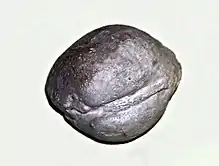
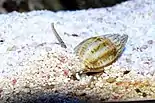
_0644_(46932258342).jpg.webp)
